World War II
The Second World War (1 September 1939 - 2 September 1945) was the second global war waged by all the great powers in the 20th century. In Europe, it began on 1 September 1939 with the invasion of Poland ordered by Adolf Hitler. In East Asia, the Empire of Greater Japan had already been engaged in the Second Sino-Japanese War with the Republic of China since July 1937 and in a border war with the Soviet Union from mid-1938. The Japanese attack on Pearl Harbor in early December 1941 resulted in the entry of the United States into the Second World War and the beginning of the Pacific War, in which the European colonial powers also became involved. In the course of the war, two military alliances were formed, known as the Axis Powers and the Allies (Anti-Hitler Coalition). The main opponents of the Nazi German Reich in Europe were the United Kingdom, headed by the war cabinet of Prime Minister Winston Churchill, and (from June 1941) the Soviet Union, under the dictatorship of Joseph Stalin. Many historians today argue that the Second World War only became a world war with the entry of the USA, as this in 1941 linked the previously regional wars in Asia (1937) and Europe (1939).
With the unconditional surrender of the Wehrmacht, hostilities in Europe ended on 8 May 1945; the two atomic bombs dropped on Hiroshima and Nagasaki led to Japan's surrender on 2 September 1945 and thus to the end of the war.
More than 60 states around the world were directly or indirectly involved, and more than 110 million people were under arms.
The numbers of casualties in the war can only be estimated. More than 60 million people were killed in the fighting on land, at sea and in the air war. Estimates that include victims of the Holocaust (Shoa), Porajmos and other mass murders, forced labour and war crimes and consequences of war range up to 80 million.
In Europe, the Second World War consisted of blitzkriegs, campaigns of conquest against neighbouring German countries with the incorporation of occupied territories, the establishment of puppet governments and area bombardments. In the territories conquered by the Axis powers and also in Germany, an increasingly strong resistance to National Socialism formed during the war years.
For the German Wehrmacht, the course of events in the theatres of war in Europe and the Mediterranean can be divided chronologically into three main phases:
- First phase: attacks on Poland, Denmark/Norway, the Benelux countries and France, the Balkans and North Africa.
- The second phase began with the German invasion of the Soviet Union on 22 June 1941.
- The third phase followed in the west with the Allied landings in Normandy on 6 June 1944. In the east, the Red Army opened its successful Operation Bagration about two weeks later.
Six European states remained officially neutral and did not participate directly in the fighting: Ireland, Sweden, Switzerland, Spain, Portugal and Turkey (the latter until February 1945). The US government of President Franklin D. Roosevelt had declared US neutrality at the beginning of the European war, but from November 1939 the new Neutrality Act and the cash-and-carry clause allowed belligerent states to buy weapons and ammunition in the United States and transport them away on their own ships. Direct deliveries by the USA were made possible by the Lend-Lease Act passed in February 1941. In August 1940, the US Congress gave its approval for the construction of a large fleet to be deployed in the Atlantic and the Pacific.
With the entry into the war of Fascist Italy, ruled by Benito Mussolini and allied with the German Reich, parts of East and North Africa as well as the Mediterranean region also became the theatre of war from June 1940. In the East African campaign, Italian troops fought against British units for the colony of British Somaliland. In the parallel African campaign, the German Afrika Korps supported the Italians from February 1941. After the two battles at El-Alamein in July 1942 and October/November 1942, Anglo-American troops landed in Morocco and Algeria (Operation Torch) and the German and Italian troops had to surrender after the Tunisian campaign in May 1943.
The war against the Soviet Union was waged by the German Army, Waffen-SS and Luftwaffe as a war of extermination with the intention of winning Eastern Europe as far as the Urals as a (new) German settlement area for a future "Greater Germanic Reich". The great turning point in the war was the fighting around Moscow (winter 1941/1942) and the futile attempt to conquer Stalingrad from autumn 1942 onwards. The west bank of the Volga at Stalingrad marked the easternmost point of the German advance on the Eastern Front. After the victory in the Battle of Stalingrad, the Red Army counterattacked - from 1943 to the end of 1944, the occupied territories of the Soviet Union were gradually recaptured by the Red Army. With the destruction of Heeresgruppe Mitte in the summer of 1944, German defeat was inevitable. The German army units retreated to what were then the eastern borders of the Reich. The joint attack by the Western powers (Great Britain, the USA and Canada) on three fronts in Europe - the landing on Sicily (July 1943), the landing in Normandy (June 1944) and the landing in southern France (August 1944) - formed a step towards a foreseeable end to all fighting in Europe.
After the Western Allies crossed the German western border in the Aachen area in October 1944 and the Red Army crossed the eastern border in East Prussia, fighting began on German territory. In their winter offensive of 1945, Red Army troops reached the Oder River on a broad front and opened the battle for Berlin in mid-April. On 25 April 1945, US troops clashed with Soviet troops on the Elbe. After Hitler committed suicide in the Berlin Führerbunker on 30 April 1945, the German troops in the city surrendered two days later. On 8 May 1945, Field Marshal Keitel signed the unconditional surrender of the Wehrmacht; the war in Europe was thus ended. The end of the war was celebrated by the victorious powers with several parades, including the Moscow Victory Parade of 1945 and the Berlin Victory Parade of 1945.
The Empire of Japan, which had been allied with the German Empire and Italy in a three-power pact since 1940, had destroyed most of the US Pacific fleet in the attack on Pearl Harbor on 7 December 1941. The USA now declared war on Japan, which was followed by declarations of war on the USA by Germany and Italy. The USSR remained neutral towards Japan for the time being in accordance with the neutrality pact of 13 April 1941.
At the Arcadia Conference in Washington (December 1941/January 1942), the USA and Great Britain decided to defeat Germany first as the most dangerous opponent ("Germany first"). But from 1942 to 1945, protracted fighting also took place in East Asia (China, Burma, British Malaya, Thailand, French Indochina, Dutch India), the Philippines and many islands in the Pacific (including New Guinea). The Japanese troops were able to occupy many of the European colonies and other countries such as Thailand and the Philippines by mid-1942. It was not until the Battle of Midway in early June 1942, in which the Imperial Japanese Navy lost four of its six large aircraft carriers, that the tide turned in the Pacific War. The Allied soldiers were subsequently able to occupy even smaller Pacific islands in "island jumping", often only with great losses. To hasten the end of the fighting in East Asia, the new US President Harry S. Truman ordered in July 1945 that one atomic bomb each be dropped on Hiroshima and Nagasaki. On 2 September 1945, the Second World War ended with Japan's surrender.
"This war was a historically unprecedented attack on humanity, a destruction of all the cultural ideals that the Enlightenment had produced, a crash the likes of which had never been seen before. It was Europe's Armageddon." In addition to the loss of human life, many historic districts and buildings were irretrievably lost through the destruction of entire cities. This loss was followed by the reconstruction of affected European cities, whose cityscapes would be as if changed by war and new construction.
As a result of the Second World War, the political and social structures throughout the world also changed. The United Nations Organisation (UNO) was founded, whose permanent members in the Security Council became the main victorious powers of the Second World War: USA, Soviet Union, China, Great Britain and France. The European colonial powers Britain and France lost their overseas possessions and most of their colonies became independent. "Only with the fall of the Berlin Wall in 1989 and the end of the Cold War did the phase of history marked by the Second World War [...] come to an end."
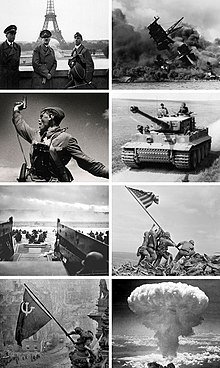
Impressions from the Second World War: Albert Speer, Adolf Hitler, Arno Breker in front of the Eiffel Tower, June 1940 - sinking "USS Arizona" after the attack on Pearl Harbor, 7. 12. 1941 - Soviet battalion commander leading the attack with his pistol, 12. July 1942 (photo by Max Alpert) - German tank "Tiger", March 1944, Northern France - landing of the 1st US Infantry Division, 6 June 1944 at Omaha Beach - GIs raising US flag, 23. 2. 1945, Iwojima - Soviet flag on the Reichstag, May 1945 - atomic mushroom cloud of "Fat Man" over Nagasaki, 9. 8. 1945
Previous story
→ Main article: Prehistory of the Second World War in Europe and Prehistory of the Second World War in the Pacific Region
In the years from 1920 to the end of the Second World War in 1945, fascism or right-wing extremism increasingly gained political dominance in large parts of Europe. In Italy, Benito Mussolini was already given power in 1922 with the March on Rome. In Germany, National Socialism grew into a mass movement after 1930. On 30 January 1933, it and its right-wing conservative allies were handed political power when Reich President Paul von Hindenburg appointed Adolf Hitler as Reich Chancellor. The latter formed Hitler's cabinet from National Socialists and German Nationalists.
The revision of the international order after the Treaty of Versailles, already a goal of earlier German governments, was part of the programme of the National Socialists and their allies. With the unification of the Saar region with the German Reich in 1935 and the reintroduction of compulsory military service (also in 1935), the invasion of the demilitarised Rhineland in March 1936, the "Anschluss of Austria" (March 1938) and the separation of the Sudetenland from Czechoslovakia in the Munich Agreement (30 September 1938), the Versailles peace order was gradually dissolved. This was facilitated by the British and French appeasement policy, which aimed at a peaceful understanding with National Socialist Germany. After the "break-up of the rest of Czechoslovakia" in March 1939, only the British and French governments protested. Shortly afterwards, Lithuania returned the Memelland to Germany under the pressure of circumstances. The First Slovak Republic became a German vassal state, closely bound to Germany by a "protection treaty". Great Britain and France wanted to limit German expansionist ambitions and issued a declaration of guarantee for Poland on 31 March 1939, which was converted into a formal alliance a short time later.
As early as October 1935, Italy, which maintained close relations with the German Reich, attacked Ethiopia and occupied Albania on 7 April 1939.
In the Spanish Civil War, a Popular Front government led mainly by Republicans, Socialists and Communists and supporters of a military revolt led by General Francisco Franco fought each other from 1936 to 1939. The Soviet Union and the French Popular Front supplied the "Popular Front" with weapons and war material. Italy and Germany supported Franco's Nationalist troops. The German government sent the Condor Legion for this purpose, the Italian the Corpo Truppe Volontarie (CTV), which contributed decisively to the victory of Francoism.
On 23 August 1939, Germany and the Soviet Union surprisingly concluded a "non-aggression treaty between Germany and the Union of Soviet Socialist Republics", later called the "Hitler-Stalin Pact". In a secret additional protocol, it was decided to divide Europe into geographically precisely designated but otherwise undefined "spheres of interest". This ultimately amounted to the division of Poland between Germany and the Soviet Union and the unilateral conquest and occupation of further territories (including the Baltic states and parts of Finland and Greater Romania) by the USSR.
In the Munich Agreement (September 1938), Germany, Great Britain, France and Italy agreed on a peaceful solution to the Sudeten crisis, although Hitler would have secretly preferred a warlike solution even then.
The Japanese expansionist policy began in the 1930s, when the influence of the military leadership on the imperial government grew stronger. Japan saw itself as a protective and regulatory power, destined to dominate the other East Asian peoples. The raw material deposits and the reservoir of labour offered by the neighbouring countries were to benefit the Japanese economy. The main interest was initially the Republic of China, whose heavily industrialised region of Manchuria had already been annexed in 1931 and declared a protectorate of Manchukuo. In response to international protests, Japan withdrew from the League of Nations in 1933. At the end of 1936, Germany and Japan concluded the Anti-Comintern Pact. In mid-1937, Japan started the Second Sino-Japanese War.
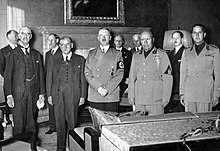
From left: Chamberlain, Daladier, Hitler, Mussolini and Count Ciano, Munich 29 September 1938
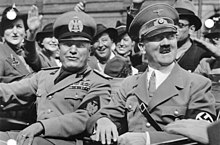
Benito Mussolini and Adolf Hitler shortly after their arrival in Munich, 28 September 1938
War aims and conduct of the great powers
The possibility that a full-scale war could occur was taken into account by the great powers, so they made preparations accordingly. The preparations for war therefore included, for example, the stockpiling of resources and goods essential for war and the expansion of civil defence programmes.
Axis powers
Germany
In the European context, the Second World War was a war of robbery, conquest and extermination launched by National Socialist Germany with the long-term goal of creating an unassailable German empire of conquered and dependent territories. From the beginning, the goal was German world power and the "racist reorganisation of the [European] continent". In the process, classical power-political motives were mixed with racial ideological ones. These included, on the one hand, the acquisition of "living space in the East" with resettlement or extermination of the predominantly Slavic peoples living there who were considered "racially inferior", and, on the other hand, the "final solution of the Jewish question". Both were justified by the anti-Semitic idea of a "Jewish Bolshevism" as part of a conspiracy of "world Jewry", which in the form of the Soviet Union was seen as a threat to the foundations of life of the "Aryan race" and the European civilisation represented by it.
According to the will of the National Socialist leadership, the ethnic group of Slavs was first to be subjugated and the conquered Eastern Europe was to be made usable by German settlers, so-called military farmers (cf. map on the right). After the destruction of their elite, the Slavic peoples were to provide forever a reservoir of uneducated and subservient agricultural and unskilled labourers. The European part of the Soviet Union was to be divided into territories under the direction of imperial commissars. Only White Russians, Ukrainians and Baltic peoples were considered worthy of living. According to Alfred Rosenberg, "Russianness [...] would certainly face very difficult years".
The German strategy envisaged the use of a politically and temporally limited opportunity for a strategic offensive. It pursued military, racial-hegemonic, economic and diplomatic goals. In military terms, the blitzkrieg was intended to enable a rapid and extensive gain of space in order to pre-empt the emerging superiority of the enemy's armament. This strategy thus represented a special manifestation of the war of movement in combination with the decisive battle, which drew on German experience in the First World War. In economic terms, it was intended to conserve resources so as not to burden industrial capacities to the detriment of the consumer economy. There was to be no discontent among the German population because of a possible material shortage. In order to secure the "home front" and in the sense of making the best possible use of the conquered capacities, a two-front war was initially avoided, but on 31 July 1940, at the Berghof near Berchtesgaden, Hitler announced to his generals the most serious decision he had taken during the Second World War: "In the course of this conflict, Russia must be finished off. Spring 1941." (Entry in Halder's war diary, 31 July 1940). Thirdly, the plundering of the occupied territories, especially in East-Central and Eastern Europe, the enslavement of their inhabitants for the benefit of the German Reich and its "Aryan" population was intended to realise the racially motivated hegemonic ideas of National Socialism. The diplomatic acquisition of European and non-European allies was intended to secure this hegemonic position.
The indignation over the Treaty of Versailles, especially the harsh and perceived unjust demands for reparations and the one-sided apportionment of blame to the Central Powers resonated with large sections of the German population. The revision of the Treaty of Versailles and the return of the German Reich to the circle of the great powers had always been sought with particular vigour by the German generals, the monarchist and anti-republican part of the German bourgeoisie and the economic elite. For the National Socialists, they were merely a stage goal.
In August 1936, in the secret memorandum on the Four-Year Plan, Hitler demanded the operational capability of the German army and the war capability of the economy within four years in order to achieve a wartime "expansion of the living space or the raw material and food base" for the German Reich. On 5 November 1937, he specified his war aims before the military and foreign policy leaders of the Reich. He rejected autarky and Germany's return to world trade; only the acquisition of a larger living space was a way out. His unalterable decision was to solve the German spatial question by 1943/45 at the latest.
After 13 October 1943, the day the Badoglio government in Italy declared war, the German Reich was in a state of war with 34 states and had only the Empire of Japan as a notable ally. These two states, independently of each other, were fighting a hopeless war against the rest of the world. A further 18 states declared war on the German Reich by March 1945. Germany's previous allies in south-eastern Europe, Hungary and Romania, dropped out in 1944. Finland signed a separate armistice with the USSR on 19 September 1944. Bulgaria was occupied by the Red Army in September, although it was not in a state of war with the Soviet Union. In Serbia, Croatia, Macedonia and Montenegro, "people's governments" were formed in December 1944, after the Red Army had occupied Belgrade at the end of October 1944 and Tito had reached an agreement in Moscow on how to proceed. After the withdrawal of the Wehrmacht, a communist government led by the partisan supremo Enver Hoxha was formed in Tirana on 10 November 1944.
Italy
After the First World War, the Treaty of Saint-Germain gave Italy Veneto, Istria, Trentino and the German-speaking South Tyrol. In October 1935, it invaded the Empire of Abyssinia (today Ethiopia) and annexed the country. This annexation, which was contrary to international law, was part of Mussolini's declared goal of resurrecting the Roman Empire. After the annexation of Austria to the German Reich in March 1938, Mussolini took a clear position in favour of Nazi Germany. Without informing Hitler in advance, he had Albaniaoccupied in early April 1939, claiming that this was the counterpart to the German annexation of the Czech Republic some four weeks earlier. In the so-called Steel Pact of May 1939, Mussolini bound himself contractually to Hitler and the German Reich. With Italy's declaration of war on France and Britain, the country entered the war in Europe on 10 June 1940, because Mussolini's false speculation led him to believe that the war was as good as over. The Three-Power Pact at the end of September 1940 created the Berlin-Rome-Tokyo axis between Germany, Italy and Japan. Less than a year later, Mussolini also joined the German war against the Soviet Union on 23 June 1941. Four days after the Japanese attack on Pearl Harbor, Germany and Italy declared war on the USA. After the landing of British and American troops on Sicily in July 1943, the inner-party opposition in the Grand Fascist Council outvoted Mussolini and had him arrested after a subsequent visit to King Victor Emmanuel III. Italy left the Axis alliance after the Cassibile Armistice and re-entered the war on the side of the Allies.
Japan
Since its modernisation in the course of the Meiji Restoration in the years 1868 to 1877, the Japanese Empire had been striving for territorial expansion on the Asian continent, primarily to secure important raw materials. These goals focused particularly on the Republic of China, which was considered weak. Encouraged by an expansionist dynamic, Japan saw the increasing tensions in Europe as an opportunity to counter the growing influence of the USA in the western Pacific Ocean (Commonwealth of the Philippines and US outer territories). Geostrategic considerations were compounded by the frequent interference of the armed forces in the affairs of civilian leadership and a mutual cultural aversion between broad segments of the population in Japan and the United States.
Japan, similar to the German Empire in Europe, was faced with a deteriorating strategic position in East Asia over the years. The main cause was its isolation in alliance politics. The predominantly US-American unwillingness to accept Japanese expansion in the region was basically joined by China, the Soviet Union and the European colonial powers. Specifically, the Japanese Empire saw itself threatened in a fourfold geostrategic context. To the east was the US Pacific Fleet at Pearl Harbor, to the north the Soviet Union, to the west China, and to the south/southwest, in addition to the Philippines under US leadership, British Malaya and North Borneo, French Indochina and the Dutch Indies. In addition, Australia, which belonged to the British Commonwealth, with its mandate territory "Territory of New Guinea" was suitable as a base of operations against Japan due to its spatial expansion and location.
This geostrategic starting position prompted the Japanese leadership, like the German, to mix diplomatic instruments with a war of movement. After a failed advance into Soviet territory in 1938/39, it therefore concluded a neutrality pact with the USSR in April 1941. The attack on Pearl Harbor by the Imperial Japanese Naval Air Force, whose build-up was qualitative in view of the restrictions of the Washington Naval Agreement, intended above all to deal a decisive blow to the United States Navy in view of its increasing armament. In Southeast Asia itself, Japan also concentrated in the first step on neutralising concentrated military resources, such as the build-up of long-range B-17 bombers on the islands of the Philippine archipelago. The subsequent Japanese invasion of Southeast Asia served to procure raw materials, primarily oil, and was intended to cut off the USA's supply route to Australia.
Allied
Western powers
On the Western Front, the war plans of the Western powers, similar to those of the First World War, essentially envisaged an attrition of the German army. This was to be supplemented by bombing the major cities and blockading the German economic cycle.
Soviet Union
The communist leadership saw the Soviet Union surrounded by a capitalist world that was hostile in principle and considered war inevitable. For them, it was a matter of delaying the war until the five-year plans had created the potential to stand up to a confrontation. But this goal did not preclude an offensive in order to throw one's own weight decisively into the balance when the opportunity arose. With the German-Soviet non-aggression pact, Stalin believed that he had prevented joint action by the capitalist powers against the Soviet Union and could assume the role of a spectator to the self-destruction of capitalism for a longer period of time.
After the start of Operation Barbarossa, the Soviet Union consciously appropriated lessons from the preceding German rearmament. On land, it followed the German example of the Army Group, whose core consisted of mobile and heavily armoured divisions, and established centrally coordinated air fleets that enabled targeted close air support through significant improvements in the flow of information. After the preceding, politically motivated decimation of the officer corps, Stalin delegated operational leadership to Marshal Georgi Konstantinovich Zhukov, whose above-average skills enabled the successful command of several million men.
Comparison of military potentials
Size of the armed forces (in millions):
| Year | GB | USSR | USA | D.R. | Japan | Italy |
| 1939 | 0,48 | 1,60 | 0,60 | 4,52 | 1,60 | 1,74 |
| 1940 | 2,27 | 5,00 | 0,70 | 5,76 | 1,70 | 2,34 |
| 1941 | 3,38 | 7,10 | 1,62 | 7,31 | 1,63 | 3,23 |
| 1942 | 4,09 | 11,34 | 3,97 | 8,41 | 2,84 | 3,81 |
| 1943 | 4,76 | 11,86 | 9,02 | 9,48 | 3,70 | 3,82 |
| 1944 | 4,97 | 12,23 | 11,41 | 9,42 | 5,38 |
War economy
→ Main article: War economy in the Second World War
"War economy in the Second World War" was the conversion of national economies into a centrally administered economy through the total mobilisation of economic resources to secure material supplies for the army and food for the population in order to achieve the war aims in the Second World War at any cost. In the process, market mechanisms were undermined. While the respective military tactics were decisive in the beginning, the quantitative superiority of the Allies' war production significantly influenced the course of the war from 1942 onwards. Nazi Germany and Japan pursued blitzkrieg tactics, for which a high utilisation of existing industrial facilities was supposed to be sufficient to produce a wide range of modern weapon systems (broad armament) and were not prepared for a prolonged war. The Allies' aim was to win the Second World War in the manner of a war of attrition. Since 1928, the Soviet Union had systematically brought about a highly standardised mass production of weapons (deep armament). After the war began, Great Britain and the USA had also begun to favour the war economy over the consumer goods industry in the allocation of scarce resources such as materials, personnel and means of production. Only after the obvious failure of the Blitzkrieg strategy did a reorganisation of the war economy take place in the German Reich and Japan from 1942 onwards, which then led to production levels similar to those of the Allies (armament miracle). In 1944, war goods production accounted for 40% of gross national income in the USA, 50% each in Great Britain and Japan, and slightly more than 50% in the German Reich.
A common war strategy was also to cut off the opposing parties from raw material and food imports. The German Reich developed great ingenuity in replacing scarce raw materials with "home materials". Additional non-ferrous metals such as copper, brass, tin, zinc, etc. that were important for the war were procured via the "metal donation of the German people".
The war economy in the Second World War led to a significant expansion of women's labour, especially among the Allies. Forced labour was widespread in the German Reich, Japan and the Soviet Union.
Armament production in the Second World War:
| Sector | GB | USSR | USA | D.R. | Japan | Italy |
| Tank | 28.500 | 110.000 | 91.270 | 61.250 | 7.200 | light Pz(**) |
| Aircraft | 133.000 | 162.000 | 329.000 | 126.000 | 90.000 | k. A. |
| Artillery | 36.400 | 541.900 | 219.000 | 101.200 | k. A. | k. A. |
| Warships | 1.340 | 260 | 8.950 | 1.540(*) | 625 | k. A. |
(*) without submarines
(**) mainly Fiat-Pz with 2-cm-cannon
Fleet comparison (1939/41):
| Ship type | GB | USSR | USA | D.R. | Japan | Italy |
| Battleships | 15 | 1 + 2 (in B.) | 17 + 15 (in B.) | 4 | 10 + 3 (in B.) | 4 + 4 (in B.) |
| Armoured ships | - | - | - | 3 | - | - |
| Aircraft carrier | 7 | - | 7 + 11 (in B.) | - | 8 + 8 (in B.) | - |
| Heavy cruiser | 15 | 6 + 4 (in B.) | 18 + 8 (in B.) | 3 | 18 + 18 (in B.) | 8 |
| Light cruisers | 41 | - | 19 + 32 (in B.) | 6 | 20 + 17 (in B.) | 14 |
| Flak cruiser | 8 | - | 4 + 2 (in B.) | - | - | - |
| Minelayer cruiser | 1 | - | - | - | - | - |
| Destroyer | 113 | 81 | 171 + 188 (in B.) | 22 | 108 + 108 (in B.) | 128 |
| Torpedo boats | - | 269 | - | 20 | - | 62 |
| Submarines | 65 | 213 | 114 + 79 (in B.) | 62 | 63 | 115 |
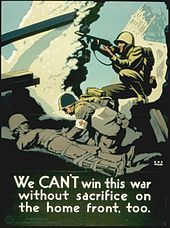
US war poster: "We cannot win this war without also making sacrifices on the home front".
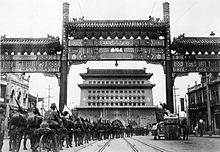
Japanese soldiers occupy the Forbidden City in Beijing, 13 August 1937
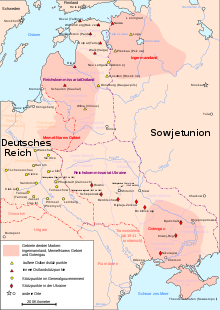
The Concept of the General Plan East, 1940 - 1943
War in Europe
→ Main article: Chronology of the Second World War, a day-by-day timeline
From the Invasion of Poland to the Defeat of France, September 1939 to June 1940
In the first phase of the war, Germany (coming from the west) and the Soviet Union (coming from the east) conquered and occupied Poland (from 1 and 17 September 1939 respectively), Germany conquered Denmark and Norway (April-June 1940) and the Netherlands, Belgium and France (May-June 1940). The rapid defeat of France was unexpected by most people, not least Josef Stalin. Nevertheless, Hitler did not achieve his main goal of keeping Britain out of the war, forcing her to surrender or defeating her militarily. This became clear at the latest in October 1940 during the air battle over Britain. Great Britain remained the only state that was consistently a capable opponent of Germany from the beginning of the war.
German invasion of Poland, 1939
→ Main article: Invasion of Poland
Hitler had set the attack for 4:30 a.m. on August 23, but withdrew the order at short notice the previous day after learning that Italy was not ready for war and that England and Poland had fixed their mutual commitments by treaty.
Hitler now ordered the Wehrmacht to attack Poland at 4:45 a.m. the following day on 31 August 1939. This directive also contained tactical instructions for the behaviour of the Wehrmacht in the west and north (Baltic Sea entrances Kattegat and Skagerrak) and forbade attacks against "the English motherland" with insufficient partial forces.
This military invasion of the neighbouring country was not preceded by a formal declaration of war. In order to justify the invasion of Poland, the German side faked several incidents, such as the fake attack on the Gliwice radio station by SS members disguised as Polish resistance fighters on 31 August. They announced in Polish over the radio that Poland had declared war on the German Reich. The flimsy trick was triggered from Berlin with the password "Grandmother died". Almost three million German soldiers had marched up to invade Poland. They had around 400,000 horses and 200,000 vehicles at their disposal. 1.5 million men had advanced to the Polish border, many with blanks to pretend they were just going on manoeuvres. The ambiguity ended, however, when they were ordered to load live ammunition.
The military attack was launched by the German liner Schleswig-Holstein on the Polish position "Westerplatte" near Danzig and the Luftwaffe with the air raid on Wieluń on 1 September 1939. The Polish army with about 1.01 million soldiers faced 1.5 million German soldiers. Technically and in terms of warfare, it was inferior. After the invasion of eastern Poland by the Red Army on 17 September 1939, the balance of power was once again dramatically shifted in favour of the aggressors. On the other hand, the Polish government counted on the support of France and Great Britain, which had issued an ultimatum to the German Reich on 2 September on the basis of the "Declaration of Guarantee of 30 March 1939". It demanded the immediate withdrawal of all German troops from Poland. The British-French guarantee declaration would have obliged these states to launch their own offensive in western Germany no later than 15 days after a German attack. Hitler assumed that the two Western powers would let him have his way, just as they had done with the invasion of "Remnant Czechoslovakia", and left the West Wall only lightly manned.
There was no attack by the Western powers, but Britain and France declared war on Germany on 3 September after the ultimatum had expired. However, Chamberlain's wartime government lasted only seven months, during which time Britain remained largely passive in the sit-down war.
By means of concentrated attacks within the framework of a "Blitzkrieg" strategy, the Wehrmacht succeeded in encircling large sections of the Polish defenders and winning encirclement battles such as those at Radom (9 September) and on the Bzura (until 19 September).
On the night of 17 September, after the Wehrmacht had crushed organised Polish defences, the Soviet occupation of eastern Poland began in accordance with the secret additional protocol of the German-Soviet non-aggression pact. The next day, the Polish government fled Warsaw for Romania via south-eastern Poland. On 28 September, President Ignacy Mościcki resigned from office in exile in Romania. It was not until 18 December 1939 that the new Polish government-in-exile declared a state of war with the Soviet Union. Great Britain and France did not join in.
Warsaw was the target of intensive air raids from 20 September until the surrender, which cost the lives of 25,000 civilians and 6,000 soldiers. The bombing was carried out with maximum force because Hitler wanted to demonstrate what could also hit French and British cities. On 26 September, about 120,000 Polish soldiers surrendered in the capital Warsaw, after being surrounded by German troops on 18 September. The Modlin fortress was surrendered on 29 September after a 16-day siege. Poland's last troops surrendered on 6 October after the battle of Kock.
On 8 October, the German Reich and the Soviet Union divided the conquered territory along a demarcation line in the Brest-Litovsk Agreement, which went down in history as the "Fourth Partition of Poland". Not only were the territories ceded under the Treaty of Versailles reincorporated into the Reich, but in addition large areas of central Poland including the city of Łódź. The rest of Poland became a German Generalgouvernement, "administered" from Krakow.
The subsequent occupation period was marked by extreme reprisals by the occupiers against the civilian population. Deportations for forced labour were only the most visible manifestation; Jews in particular became victims of the National Socialist racial and extermination policy. In the eastern part of Poland, numerous "class enemies" were deported to the Gulag by the Soviet occupiers; the military elite was "liquidated" at Katyn and elsewhere.
The tactics of the attack on Poland, designed for a quick victory - and successful in this - promoted the use of the term "Blitzkrieg" and shaped Germany's further warfare until the end of 1941.
War of Position on the Western Front, 1939
→ Main article: Seat war
On 3 September, France and Great Britain declared war on Germany. As a result, a limited and rather symbolic offensive by the French against the Saar region began on 5 September. The Germans offered no resistance and retreated to the heavily fortified Westwall. After that, things remained quiet on the Western Front. This phase is also referred to as the "Sitzkrieg". Apart from isolated artillery skirmishes, there were no Allied attacks. On the German side, the propaganda machinery started rolling. With leaflets and slogans over loudspeakers, the French were asked "Why are you waging war?" or proclaimed "We will not shoot first".
On 27 September, Hitler issued an instruction to the Army High Command to draw up a plan of attack, the so-called "Fall Gelb". By 29 October, the plans had been completed. They provided for two army groups to advance through the Netherlands and Belgium in order to crush all Allied forces north of the Somme.
In the end, however, no attack took place in 1939, as bad weather conditions and much greater losses in Poland than expected (22% losses in fighter planes, 25% in tanks) caused the attack to be postponed a total of twenty-nine times. In addition, several senior officers of the Army High Command, which was stationed in Zossen near Berlin, had urged the Commander-in-Chief of the Army, Colonel General Walther von Brauchitsch, to oppose a premature deployment of the Army against France. On 5 November, he warned Hitler not to underestimate the French. Moreover, German troops had proved poorly trained in the invasion of Poland. Hitler was beside himself and wanted to hear examples. Brauchitsch was not prepared for this. Hitler threw the humiliated general out with the remark that he knew "the spirit of Zossen" and was ready to "destroy it". Chief of General Staff Franz Halder feared that his coup plots would be exposed, and the actual opponents of the regime, essentially the group of younger officers in the OKH, abandoned their coup plans.
Finnish-Soviet Winter War, December 1939 - March 1940
→ Main article: Winter War
Since the beginning of the 1930s, Finland had adapted to the level of development of the other Nordic democracies, with which it was confessionally related through its Protestant-Lutheran character. In the field of foreign policy, they moved closer together when Finland, Sweden, Norway, Denmark as well as Belgium, Luxembourg and the Netherlands joined together in the autumn of 1933 to form the so-called Oslo States, which professed a close customs union. In 1935, the Finnish government of Toivo Kivimäki committed itself to closer cooperation with the three other Scandinavian states in order to secure their common neutrality.
On 30 November 1939, Soviet troops under the command of Marshal Kirill Merezkov crossed the Finnish border in the so-called Winter War. The Red Army attacked with 450,000 men, 2,000 tanks and 1,000 aircraft, expecting a quick victory. Their officers assumed that the Finns would welcome them as their brothers and liberators from the capitalist oppressors. The Soviet leadership underestimated the fighting strength of the Finns, who with only 200,000 soldiers, including many reservists and youth, a few tanks and planes were able to prevent the Red Army attackers from breaking through the Mannerheim Line after heavy Soviet losses. Finnish soldiers used simple but effective incendiary devices to fight tanks, which they called "Molotov cocktails" after the Soviet Union's foreign minister. The numerical superiority of the Soviet troops did not have much effect because the forest terrain and deep snow hardly permitted Red Army operations off the few roads and often only one regiment could fight at the front on paved roads. These adversities were compounded by temperatures of minus 35 °C. At the end of the Winter War, the Red Army had more than 85,000 dead and missing, the Finnish Army about 27,000 men. The Finnish army was supported by 12,000 volunteers from Sweden, although Swedish military officials had advised against it. Only after extensive regrouping and reinforcements was the Red Army able to achieve major breakthroughs on the Karelian Isthmus west of Lake Ladoga in early February 1940.
Sweden indirectly supported Finland without giving up its neutrality. Great Britain and France did not intervene in the war in favour of the Finns, as both states did not want to have another enemy in the war. The German Reich sympathised with Finland, but military support was not given because of the existing non-aggression pact with the Soviet Union.
The peace treaty signed on 12 March 1940 stipulated that Finland had to cede large parts of West Karelia and the northern half of Lake Ladoga to the Soviet Union. In direct response to the Soviet attack, Finland took part in the German war against the Soviet Union in 1941 in the Continuation War to recapture the lost territories. A significant consequence of the Winter War was also that Stalin began a reorganisation of the Red Army, rehabilitating officers who had been exiled to Siberia in the course of the Great Terror. This reorganisation contributed significantly to the Red Army having more fighting strength in 1941 than the German Army High Command had assumed. In 1947, Finland also had to cede Petsamo to the Soviet Union. At the end of the war, the Finns had lost just under 27,000 soldiers in the fighting, while the Red Army had lost almost 130,000. After the end of the Continuation War, Finland also had to cede the Petsamo area on the Barents Sea to the Soviet Union in 1944. Finland thus lost its only year-round ice-free port.
Occupation of Denmark and Norway, April 1940
→ Main article: Enterprise Weser Exercise
At the end of 1939, after the loss of iron ore imports from France (Lorraine Minette), ore deliveries from neutral Sweden covered 49 percent of German demand. These were transported from the Swedish mining areas near Kiruna by ore railway to the year-round ice-free loading port of Narvik in Norway. Norway was therefore of extraordinary economic and military importance to the German Empire. Another important raw material was Finnish nickel. The British wanted to disrupt these important supplies of raw materials and stop them as soon as possible (→Altmark incident), which is why on 5 February 1940, the supreme Franco-British war council agreed to land four divisions in Narvik. On 21 February, Hitler issued a directive for the planning of operations in Scandinavia. On 1 March, it was decided to launch the Weserübung. It envisaged taking Denmark and using it as a "springboard" for the conquest of Norway. The first attacks on British warships took place in March.
On 5 April, the Allied Operation Wilfred began, in which the waters off Norway were to be mined and more troops brought into the country. One day later, the German Unternehmen Weserübung began. Almost the entire Kriegsmarine was mobilised and half of the entire German destroyer flotilla was sent to Narvik. On 9 April, a Mountain Infantry Division was landed in Narvik.
The British military leadership considered a German landing to be quite unlikely, which meant that only minor countermeasures were taken by the Allies. The Germans were able to expand their bridgehead without major resistance, so that on 10 April Stavanger, Trondheim and Narvik were already occupied, after Denmark had already been occupied without a fight. Great Britain occupied the Danish Faroe Islands in the North Atlantic on 12 April for strategic reasons.
In the attempt to occupy the capital Oslo, heavy units of the Kriegsmarine were deployed, which were ill-suited in the narrow waterway of the Oslo Fjord. In the process, the German flagship, the heavy cruiser Blücher, whose first combat mission was her last, was sunk by Norwegian coastal batteries. Oslo was taken by airborne troops later than the Germans had planned.
On 13 April, nine destroyers and the battleship HMS Warspite sank the remaining eight German destroyers still in the Ofotfjord off Narvik in a second British attack. Two Kriegsmarine light cruisers and numerous freighters were also sunk by British submarines and Royal Air Force aircraft.
On 17 April, the Allies finally landed at Narvik and put the Wehrmacht troops under heavy pressure with simultaneous massive shelling by Royal Navy ships. By 19 April, large Allied formations, including Polish soldiers and parts of the Foreign Legion, were landed in Norway. They captured Narvik and pushed the mountain troops of the Wehrmacht back into the mountains.
In the meantime, the weather in Norway improved so that the Wehrmacht could consolidate its fronts and a British and a French destroyer could be sunk during attacks by German aircraft off Namsos on 3 May.
In the same month, Churchill decided to withdraw the Allies from Norway because of the German successes in France. However, before the 24,500 soldiers could be evacuated, they still managed to enter Narvik and destroy the important harbour. On 10 June, the remaining soldiers of the Norwegian armed forces finally surrendered, whereupon the Weser Exercise was completed.
Norway under German occupation became a Reich Commissariat and part of the German territory, but Hitler wanted it to remain an independent state. In the further course, Norway was heavily fortified because Hitler feared an invasion. In February 1942, a puppet government was established under Vidkun Quisling.
Western campaign, May/June 1940
→ Main article: Western campaign
On 10 May 1940, the attack by German units ("Fall Gelb") began with a total of seven armies on the neutral states of the Netherlands, Belgium and Luxembourg. 136 German divisions faced around 137 Allied divisions.
The Netherlands was the first to cease its resistance. On 13 May, Queen Wilhelmina and the government went into exile in London. After the rapid advance of Army Group A through the Grand Duchy and bombardment of Rotterdam, which killed 814 inhabitants of the city, the Dutch forces capitulated on 15 May 1940. Three days later, the former leader of the Austrian National Socialists, Arthur Seyß-Inquart, took office as Reichskommissar for the Netherlands. The Dutch islands of Aruba and Curaçao (South America) had great strategic importance during the World War because of their world's largest oil refineries, which is why they were shelled by German and Italian submarines in 1942.
The Belgian army resisted a little longer. By 16 May, the forts of Liège, Namur and the Dyle position had been taken, followed by Brussels on 17 May and Antwerp the next day. This enabled the German attackers to cut off the Belgian troops north of this line from the British and French formations, which in the meantime had advanced into Belgium. The Belgian government fled to Britain via France. On 28 May, King Leopold III, who remained in the country, signed the surrender against the will of the cabinet. Government President Eggert Reeder became head of the German military administration.
In order to bypass the northern section of the Maginot Line, neutral Luxembourg was used by the Wehrmacht as a transit area. Afterwards, the Grand Duchy became a so-called "CdZ area" under the control of a chief of the civil administration.
In France, the government and the military had relied on the heavily fortified Maginot Line along the Franco-German border from Basel to Luxembourg. Because the Belgian Ardennes were considered difficult for tanks to pass, the Allies considered them a natural extension of the Maginot Line. Lieutenant General Erich von Manstein's campaign plan, on the other hand, envisaged an advance through the Ardennes with six armoured and five motorised divisions to encompass the French and British troops at Boulogne and Calais from the south. Army Groups B and C were to act more defensively. This plan was helped by the fact that strong Allied forces, including the bulk of the British Expeditionary Force, were advancing far to the north to come to the aid of the hard-pressed Belgians and Dutch, thus leaving room for German troops of Army Group A in their rear. On 19 May, German units reached the Channel coast, about 100 km south of Calais. The advance further north along the Channel coast was so rapid that the British and French units were encircled at Calais and Dunkirk. This rapid and unexpected advance was later referred to by Churchill as the "sickle cut". Hitler, in agreement with von Rundstedt and contrary to the opinion of other generals, decided to spare the battered panzer force, halt its advance and leave the encirclement of Dunkirk to the Luftwaffe and the artillery regiments.
This gave the British three days to prepare for Operation Dynamo, which began on 27 May. About 1200 ships and (also private) boats were able to evacuate a total of 338,000 soldiers, including 145,000 soldiers from the French army. About 80,000 soldiers, mainly French, remained behind. The British had lost 68,000 men in the fighting. Almost all remaining tanks and vehicles, most of the artillery and existing supplies had to be destroyed. From a military point of view, Hitler's halting order, which allowed the evacuation of almost the entire British Expeditionary Corps, represented a grave tactical and, especially in retrospect, momentous mistake. The ability to continue the war would have become much more difficult for Britain after the loss of the Expeditionary Corps, as they were experienced professional soldiers. Thus, the Allies only lost the war material left on the beach, which could be more easily replaced. But Churchill's rousing speeches also invigorated British courage in May and June 1940 and strengthened the sense of what the war meant for the survival of freedom and democracy.
As the British retreated, France prepared to defend itself. The "Fall Red", the actual battle for France, began on 5 June with a German offensive on the Aisne and the Somme. On 9 June, German soldiers crossed the Seine. On 10 June Italy entered the war on Germany's side and on 21 June began an offensive in the Western Alps, although Pétain's government had asked Italy for an armistice on 20 June. On 14 June, parts of the 18th Army occupied the French capital, Paris. To prevent its destruction, it had been declared an open city and evacuated by French troops without a fight. On the same day, German troops broke through the Maginot Line south of Saarbrücken and the symbolic fortress of Verdun was also taken.
After German troops reached Orléans and Nevers on the Loire (260 km south of Paris) as well as Dijon on 17 June, a request for an armistice from Philippe Pétain, Prime Minister of the newly formed French government, arrived at Hitler's headquarters. The Führer was then praised by Keitel as "the greatest general of all time". Hitler met with Mussolini in Munich on 18 June to agree the armistice terms with him. Hitler rejected the Duce's far-reaching demands, including Nice, Corsica and Savoy as well as the use of ports and railways in Africa for military purposes. He was concerned to prevent the French fleet and the colonies from continuing the war. Nevertheless, Italy began an offensive in the Alps on 21 June, which resulted in only minor gains, including Mentone. The terms of the armistice were presented by Keitel to French General Charles Huntziger in the Compiègne carriage on 21 June 1940. On 22 June, the French delegation, having had almost all their counter-proposals rejected, signed the armistice treaty. It came into force at 01:35 on 25 June, after the Italian-French armistice had also been signed the day before. France was only allowed to maintain 100,000 soldiers with light weapons; artillery and tanks were not allowed. On 1 July 1940, the Wehrmacht demonstrated its victory over France with a grand parade on the Champs-Elysees in Paris.
The so-called "Blitzkrieg" in the West had lasted only six weeks and three days, in which about 100,000 French, 35,000 British and about 46,000 German soldiers lost their lives. French fighter pilots shot down several hundred German fighter planes and almost 1,000 German fighter pilots were taken prisoner. France was divided into two zones: The north and west of France were German-occupied; here were important airfields and naval bases (including Brest, Lorient, St. Nazaire, La Rochelle and Bordeaux) for the war against Great Britain.
The Wehrmacht attack prevented the execution of Operation Pike, which was in preparation, with which England and France wanted to destroy the oil sources of the Soviet Union in order to bring about a "complete collapse" of the Soviet Union.
Follow
Politically and strategically, the German Reich found itself in a situation after the victory in the West that opened up fundamentally new options for it to continue the war: for the war against Great Britain in the West, it had shifted the balances in the Mediterranean, and it was able to draw on the economic resources of Western Europe, Central Europe and Eastern Central Europe and thus sustain the war for a long time, including. These included industrial goods from the Protectorate of Bohemia and Moravia, iron ore from Sweden shipped to Germany via the Norwegian port of Narvik, agricultural products from Poland, Denmark, the Netherlands and Greece, industrial goods from Belgium and France, tungsten from Portugal and oil from Romania. Neutral Switzerland could be used for international money transactions and foreign exchange deals.
Three battleships of the French fleet anchored in Mers-el-Kébir were sunk or severely damaged by Royal Navy ships on 3 July 1940 on Churchill's orders, following a British ultimatum that remained unanswered, to prevent them from falling into German hands (Operation Catapult). This resulted in the deaths of 1297 French sailors. The eastern and southern parts of France remained under French control. Marshal Philippe Pétain ruled the so-called "État français" from Vichy as a puppet state of the German Empire.
In November 1942, the previously unoccupied zone was occupied by German and Italian troops after Anglo-American troops landed in North Africa. The 50,000 soldiers of the Vichy government offered no resistance to the Germans and Italians. The rest of the demobilised French navy was sunk by the crews in the port of Toulon.
From the Surrender of France to the Attack on the Soviet Union, June 1940 to June 1941
Despite France's capitulation, the war continued because Britain did not accept Hitler's so-called peace offer of 19 July 1940. Although the outcome of the war with Britain was still completely open, Hitler announced to the generals as early as 31 July his basic intention to have an attack on the Soviet Union prepared for 1941. Shortly afterwards, on 17 September, he postponed Unternehmen Seelöwe indefinitely.
Hitler sought to consolidate his rule over the "New Europe" and secure it through further alliances with Spain, France, Hungary, Romania and Bulgaria. Franco and Pétain opposed a formal alliance with Germany.
France libre
→ Main article: Forces françaises libres
Charles de Gaulle (1890-1970), previously military secretary of state, became an organiser of the resistance as the "leader of Free France" from exile in London. Mocked by the Vichy regime's propaganda as Le Général micro and Fourrier (rations sergeant) of the Jews, he called on his compatriots to resist. As early as 18 June 1940, he had addressed all French people in a radio speech: "France has lost a battle. But France has not lost the war!" He predicted that the industrial potential of the United States would turn the tide in this war. He thus rejected the opinion of defeatists that Britain would be defeated within three weeks.
Air Battle for England, 1940/1941
→ Main article: Battle of Britain
National Socialist propaganda referred to the preparations for an invasion of Great Britain by eliminating the Royal Air Force as the "Battle of Britain". Hitler did not believe in success and preferred a peace treaty with Great Britain, admittedly only if it would return the former German colonies and renounce influence in Europe.
In the two years between the Munich Agreement and the "Battle of Britain", the British had improved their air defences. Chain Home radar stations were installed on the south and east coasts of the British Isles. British industry was able to produce more than 1400 fighter planes in the three months before the start of the Second World War. The Royal Air Force (RAF) successfully recruited pilots from the Commonwealth, France, the USA, Poland and Czechoslovakia, as there were six German pilots for every RAF pilot. It was a similar story with the aircraft: In the Western campaign, there were about four German fighters and bombers for every British fighter. For this reason, Dowding also used foreign volunteers as fighter pilots, initially from the Commonwealth countries Canada, Australia and New Zealand, but then also from Poland, the Czech Republic and France. One fifth of the almost 3000 "Spitfire" or "Hurricane" pilots deployed in the Battle of Britain did not come from Great Britain.
On 2 July, Göring began the air battle with a limited offensive against shipping in the English Channel. Hugh Dowding, commander of the British air defence, did not accept the challenge. The next phase began in mid-August. The RAF was to be crushed by destroying its aircraft in the air, while the fight against shipping continued. In August and September, British fighters shot down 341 German aircraft and lost 108 themselves. The RAF had the advantage that the pilots of the downed aircraft were not lost to them every time, provided they managed to save themselves by parachute. In the next phase, the Luftwaffe concentrated its attacks on London. Hitler spoke of retaliation and total annihilation after 60 RAF bombers had flown a raid on Berlin on the night of 26 August on Churchill's orders, causing little damage. On 7 September, the Luftwaffe attacked the London docks with 300 bombers and 600 fighters, but again lost more aircraft than the British fighter squadrons. On 15 September, the German attacks, dubbed "The Blitz" by the British, peaked with two days of raids. The German bombers were decimated and the fighters repulsed. The decision to attack London is considered a major strategic mistake with far-reaching consequences, for further attacks on London until the end of the year with an average of 160 bombers achieved little, militarily speaking, but were extremely costly for the Luftwaffe. On 17 September 1940, Hitler postponed "Unternehmen Seelöwe" indefinitely.
The Luftwaffe continued its night raids throughout the winter and spring, not to prepare for invasion but to hit industry and demoralise the population. In the Luftwaffe attack on Coventry on the evening of 14 November 1940, factories such as Armstrong Siddeley's aircraft engine works were targeted, but incendiary and demolition bombs also hit three quarters of residential areas, killing 568 residents. The term "coventrieren", a coinage of the Reich Minister for Popular Enlightenment and Propaganda, Joseph Goebbels, subsequently found its way into German military jargon.
In total, about 43,000 civilians lost their lives in air raids on London, Coventry and other British cities in 1940/41. In London alone, 14,000 people were killed in 57 night raids between 9 September 1940 and New Year's Day 1941. In October 1940, the Luftwaffe had lost 1733 fighter aircraft, the RAF 915.
"The air battle ended as a military stalemate, but was a political and strategic defeat of the first order for Hitler, who for the first time had failed to impose his will on a country." Contributing factors to the Luftwaffe's failure were the misjudgement of the effectiveness of the British radar systems and guidance system, and the lack of range of the German fighter planes. The British aircraft factories also produced more machines than the German ones.
With the end of the air battle, "the invasion was also over. On 18 December 1940, Hitler issued his formal instructions for Unternehmen Barbarossa, "to strike down Soviet Russia in a swift campaign even before the end of the war against England." Hitler's decision was also informed by "achieving final victory in the war by defeating London via Moscow". From May 1941 onwards, German air raids on Britain decreased significantly because bombers and fighter planes were needed for the imminent attack on the Soviet Union.
A total of 61,000 British lost their lives in German air raids, 8,800 of them in attacks with the "retaliatory weapons" V1 and V2.
Hitler's Alliance Policy
After the war enemy Great Britain could not be defeated, Hitler looked for a way out. In his mind, two possibilities presented themselves: an attack on British positions in the Mediterranean or an attack on the Soviet Union, whose exploitation as a "living space in the East" had long been an integral part of his ideology.
First, he turned to the Mediterranean option. In June 1940, Spain's dictator Franco was still prepared to enter the war on Germany's side. In return, he demanded Gibraltar, French Morocco, Oran and the expansion of the Spanish Sahara and Spanish Guinea colonies, as well as extensive deliveries of weapons, raw materials and food. Hitler did not consider Spain's support necessary at the time and made evasive replies. When he met with Franco in Hendaye on 23 October, however, Hitler showed a much greater interest in Spain's entry into the war, which he proposed for January 1941. Spanish and German troops could conquer Gibraltar and thus seal off the Mediterranean to the west. Foreign Minister Ribbentrop even went a step further and ventilated the idea of an anti-British continental bloc from Spain to Japan. Franco and Súñer, his son-in-law and later foreign minister, however, were no longer convinced that Britain would soon be defeated. They were not tempted to take rash steps and repeated deliberately exaggerated demands for the supply of arms. Hitler, in turn, had to be considerate of Vichy France with regard to Spanish colonial desires in North Africa. Franco therefore only agreed to sign a protocol in which Spain declared its willingness to become a member of the Three-Power Pact and to enter the war - with the reservation that the timing was still to be jointly agreed. This made the agreement practically worthless for Hitler. In the internal circle, he later "raged" about the "Jesuit pig" and the "false[n] pride of the Spaniard".
As in Hendaye with regard to Spain, it remained open in Montoire-sur-le-Loir at two meetings with Pétain and Laval on 22 and 24 October 1940 whether there would be concrete cooperation with France. Hitler wanted to achieve, if not a declaration of war on England, at least the defence of the French colonies in North Africa and the Middle East against attacks by the FFL and the British, as well as the surrender of bases on the African Mediterranean and Atlantic coasts for the naval war against Great Britain. Marshal Pétain agreed in principle to cooperation with Germany, but indirectly rejected France's entry into the war by having it pointed out that a declaration of war could only be made by parliamentary resolution. Such a decision was questionable. The result of the meeting was therefore meaningless for the war against Great Britain. Nevertheless, Pétain indicated in a radio speech a few days later that he would take the path of collaboration with Germany.
Italy had become Germany's wartime ally in June 1940, shortly before the French surrender. The Japanese ambassador Saburō Kurusu and the foreign ministers Galeazzo Ciano (Italy) and Joachim von Ribbentrop (Germany) signed the Three-Power Pact in Berlin on 27 September 1940, which provided for mutual assistance in gaining hegemony over Europe and East Asia respectively. The provisions were not directed against the Soviet Union; rather, the USA was to be deterred from entering the war. Although the pact was a great propaganda success, it had no immediate effect on the formation of an active front against Britain.
In Eastern Europe, Hitler gained Romania as an ally, which was extremely valuable to him because of its strategic location and the oil fields near Ploiești. It is true that he let the Soviet Union claim Bessarabia, which had been lost after the First World War, as provided for in the Hitler-Stalin Pact. But Hitler guaranteed Romania's existence in the summer of 1940, which in turn withdrew from the League of Nations.
Italian Parallel War in the Mediterranean and East Africa, 1940/1941
→ Main articles: Italian invasion of Egypt, East African campaign and Greece - from independence to the Second World War
Mussolini hoped that after the German Axis partner, Italy could also achieve military successes, although King Victor Emmanuel III had still made the realistic assessment in 1939 that the army was in a pitiful state and the officers were no good. After Italy entered the war on 10 June 1940, Mussolini ordered British positions in the Mediterranean and in North and East Africa to be attacked. After minor initial Italian successes in Egypt and East Africa, the initiative was lost in the late summer and autumn of 1940. Counter-offensives by British and Commonwealth forces (Operation Compass) led to Italian defeats in Egypt, the eastern part of Libya (Cyrenaika) and East Africa in early 1941.
130,000 Italian soldiers fell into British captivity. In February 1941, Hitler reacted by sending the German Africa Corps (Unternehmen Sonnenblume) to at least prevent Italy from losing the colony of Libya. In East Africa, Italy lost 30,000 soldiers (24,000 prisoners of war and 6,000 killed in action) and its colonies there by the end of November 1941.
Mussolini's great power ambitions had already been directed towards the Balkans since the 1930s. On 28 October 1940, Italian forces attacked Greece (Greek-Italian War). Mussolini believed in a quick victory; instead, the war turned into a fiasco. The Greek troops were well organised and knew their way around the difficult terrain of the Pindos Mountains. "Within a fortnight, the expected triumph had turned into a humiliation for Mussolini's regime" when the attackers had been pushed back beyond the borders of Albania.
More significantly, the Axis position in North Africa was seriously weakened because, in the face of the looming debacle, urgently needed Italian troops were transferred from there to Greece. Yet North Africa was of utmost importance: if the weak British troops had been driven out of Egypt and away from the Suez Canal, the world war would have taken a different course.
Balkan campaign, 1941
→ Main article: Balkan campaign (1941)
At the beginning of 1941, the German Reich tried to mediate in the Balkan conflict. Hitler proposed to the Kingdom of Yugoslavia that it join the Three-Power Pact, but this was rejected. Greece also renounced any attempt at mediation, as its army was able to force the Italian soldiers at the front to retreat. A major Italian offensive on 9 March turned into a disaster. On 27 March, Yugoslavia finally joined the Three-Power Pact. The result was anti-German demonstrations and a coup d'état by the Serbian officer corps against the government of Prince Regent Paul, whereupon the accession was reversed.
This unexpected turn of events led to Hitler's decision to attack Yugoslavia. He justified the attack as retaliation against a Serbian "criminal clique" in Belgrade. On 6 April, units of the Wehrmacht crossed the border into Yugoslavia and the Luftwaffe began to reduce Belgrade to rubble (→ Unternehmen Strafgericht), even though the capital had been declared an "open city". The further advance took place as if in a planned manoeuvre. On 10 April, Zagreb was occupied, where the Independent State of Croatia was proclaimed on the same day. Belgrade was occupied by German troops on 13 April. On 17 April, the Yugoslav commanders signed the surrender of the Yugoslav army.
The German campaign against Greece also began on 6 April. Unlike in Yugoslavia, the Greek resistance was extremely tough in places. Especially in the mountainous areas and in the area of the strongly defended Metaxas Line, German soldiers advanced only slowly and with heavy losses. On 9 April, Salonika fell. At the same time, the Greek army in eastern Macedonia was cut off and the Metaxas Line was pressed harder. The Greek reinforcements from the Albanian front were held up by German and Italian tank units and air attacks as they advanced through the mountainous countryside. On 21 April, 223,000 Greek soldiers were forced to surrender.
Meanwhile, the British units stationed in Greece built up a defence at Thermopylae. This was overrun on 24 April, whereupon the Allies had to launch an amphibious evacuation operation in which 50,000 soldiers were shipped to Crete and Egypt. On 27 April, the Wehrmacht entered Athens.
Hitler ordered on 25 April to conquer Crete with airborne troops, paratrooper units and the 5th Mountain Division in mid-May 1941. On 20 May 1941, German paratroopers landed on Crete. They suffered heavy losses in the process. The landed units were initially unable to capture airfields for supplies and reinforcements. Only through increased use of the Luftwaffe and after successful landings on contested airfields did the situation stabilise for the attackers. The Allies, including New Zealanders and Australians, defended Crete for a week until they had to withdraw to Egypt with about 17,000 men. Due to the high German losses, Hitler decided not to carry out any more air landings in the future. The attempt to conquer the strategically important island of Malta was therefore abandoned.
From the Emergence of the Eastern Front to the Western Front, June 1941 to June 1944
The intention to invade the Soviet Union was discussed by Hitler in a circle of the highest generals on 31 July 1940 - in parallel with the invasion plans against Great Britain. At that time, Hitler still hoped that Britain would give up sooner or later and that, on the basis of an "understanding with England", he could throw all his strength eastwards to tackle his great goal of conquering "Lebensraum in the East". If Russia was defeated, then England's last hope was extinguished. On 18 December 1940, the order was given to attack the Soviet Union in May 1941. The background to this decision was also the realisation of the impossibility of landing on the British island as long as the air force and navy were too weak to do so. Even if not the sole motive, the desire to force London to withdraw from the war via Moscow was behind it. An attack on the Soviet Union was considered by Hitler to be of little risk because he completely underestimated the political stability of the Soviet Union and its military potential. To Mannerheim, in a confidential conversation in Finland on 4 June 1942, which was recorded without Hitler's knowledge, he openly admitted this underestimation. Hitler was not alone in his misjudgement of Soviet military potential; almost all his commanders shared it as well. On 30 March 1941, he announced to more than 200 senior officers in the Reich Chancellery that the forthcoming war was a race-ideological war of extermination and was to be waged without regard to the norms of international law. The commanders would have to overcome any personal remorse. In the East, "harshness is mild for the future." None of those present took the occasion to raise Hitler's demands for discussion again afterwards.
With the attack on the Soviet Union, Unternehmen Barbarossa, a new front emerged in eastern Germany on 22 June 1941. It became the longest-lasting front in the Second World War (along with the Japanese-Chinese front), which claimed the most victims. The German troops conquered huge areas of the European part of the Soviet Union; together with immediately following units of the SS and Einsatzgruppen, they had the task of ruthlessly exploiting the areas, killing part of their inhabitants and forcing the others into forced labour. In the process, many tens of thousands of Jews were systematically killed.
Six months later, Hitler's declaration of war made the USA, which had already indirectly supported Great Britain, Germany's official enemy. America needed time to adjust its economy to the war. A confrontation of the Wehrmacht with Anglo-American land forces took place for the first time in November 1942 in North Africa (Operation Torch).
War against the Soviet Union, June 1941 to October 1942
→ Main article: German-Soviet War
The Balkan campaign had postponed the time for an attack on the Soviet Union by four weeks. The attack did not take place until 22 June 1941. Although calculations on the German side showed that it was only possible to supply the Wehrmacht up to a line along Pskov, Kiev and the Crimea, Hitler demanded the conquest of Moscow as part of a single, uninterrupted campaign. This showed his dangerous underestimation of the Soviet Union, which had already been expressed after the surrender of France in June 1940 (see above). Three army groups (North, Centre, South) were ready for the invasion. Army Group North (von Leeb) was to conquer the Baltic states and then advance to Leningrad. The main burden lay on the Central Army Group (von Bock). It was to advance towards Moscow and was equipped accordingly. Army Group South (von Rundstedt) was to conquer the Ukraine. From occupied Norway, attacks were also launched against the Soviet Union. They targeted Murmansk, the harbour and the railway connection there, the "Murman Railway". The campaign also involved 600,000 soldiers from allied, neutral and occupied states. Later, 30,000 volunteers from neutral and occupied territories (among others Poland, Estonia, Latvia, Lithuania, Belarus, Ukraine, Russia, Caucasus) joined, mostly representatives of radical right-wing or fascist currents in their home countries.
In the early morning of 22 June 1941, between 3:00 a.m. and 3:30 a.m., the attack against the Soviet Union began. Although he had received several serious indications, including from Harro Schulze-Boysen, Arvid Harnack and Richard Sorge, Stalin remained convinced that Hitler would not attack the Soviet Union before defeating Britain. The attack was led by 153 German divisions, including 19 armoured and 12 motorised divisions, over a front length of 1600 km between the Baltic Sea and the Carpathian Mountains. Two divisions operated from Finland. Army Group North occupied the three Baltic states of Lithuania, Latvia, Estonia and reached Novgorod in early September. Army Group Centre reached Smolensk, on the direct route to Moscow, in the same period. Army Group South had the task of conquering Ukraine and at the same time was just outside Zaporozhye in south-eastern Ukraine. The Red Army's military commanders were not prepared for this largest military offensive in world history to date, involving just over three million army soldiers. Within a week they were joined by soldiers from the allied states of Romania, Italy, Slovakia and Hungary, as well as Finland, which had no alliance with Germany and made a point of stating that it was waging a "war of continuation" against the Soviet Union to recapture the territories it had ceded in 1940. The Red Army had nearly three million soldiers stationed on its western border, whose tanks, artillery and aircraft far outnumbered the attackers but were not ready for battle. Many of the Soviet soldiers on the border surrendered without resistance, while the motorised German troops were initially able to advance swiftly. The ability of the Soviet forces at that time to wage an attack or war against Germany must be strongly doubted, even according to more recent findings. The first Wehrmacht report on the morning of 22 June 1941, on the other hand, gave the impression that Soviet troops had entered East Prussia. It thus supported the preventive war legend of Nazi propaganda, which portrayed the attack as a defensive war. In fact, the invasion of the Soviet Union was essentially a war of conquest and extermination dressed up ideologically, with the goal of gaining "living space in the East" formulated by Hitler years earlier. This meant "a blockade-proof large empire" as far as the Urals and beyond the Caucasus.
On 22 June at noon, the Soviet Foreign Minister Molotov read out a speech on the radio in which he announced the outbreak of war. It was not until eleven days later that Josef Stalin addressed the people in a radio speech on 3 July. Before that, Minsk had been surrounded and occupied a little later. For a long time, Hitler insisted to the OKH on the priority of conquering Ukraine instead of Moscow. The main aim of the Nazi leadership was to secure the oil reserves of the Caucasus and the grain in the Ukraine. This, Hitler believed, would make them invincible. Despite victorious encirclement battles, the Barbarossa plan failed as early as August 1941, triggering the so-called "August Crisis" because large parts of the enemy escaped from these battles and regrouped, the surprise effect of the invasion wore off, German losses increased and Hitler's "zigzag of orders" to focus on Army Group Centre or Army Group South became more frequent.
Only after the capture of Kiev and Kharkov was the advance on Moscow resumed on 2 October. But already in October it began to rain, and in November frost set in with minus 22 degrees Celsius. As a result, the German offensive slowed down, becoming increasingly bogged down in mud or snow, and the attack on Moscow came to a halt on 5 December due to arctic temperatures of up to minus 50 °C and the stiffening Soviet resistance. The following day, a Soviet counter-offensive with units from the Far East, well equipped for winter warfare, began under the command of Zhukov, preventing the capture of the capital Moscow by German troops. The flight of the army group could be stopped by an unconditional halting order by Hitler, but his goal of "throwing down the Soviet Union in a swift campaign" had failed, "Barbarossa" had failed. The lost battle for Moscow was the geopolitical turning point of the Second World War, "the real caesura", because the series of German lightning victories came to an end. The Wehrmacht lost about a third of its soldiers by the end of January 1942. Only half of the one million killed, missing or wounded could be replaced. The Red Army suffered even heavier losses, with around 3.3 million prisoners, an unknown number of dead and 2.2 million wounded and sick.
In the Continuation War, Finland attempted, with German support, to recapture the territories in Karelia lost to the Soviet Union in the Winter War. After achieving this goal in the summer of 1941, however, Finland did not remain defensive, but occupied disputed Karelian territories that had never before been Finnish until December 1941.
In response to the German attack, British and Soviet troops invaded Iran on 25 August 1941 as part of the Anglo-Soviet Invasion. The aim of the attack was, on the one hand, to secure the oil production of the Anglo-Iranian Oil Company and, on the other hand, to take over the Trans-Iranian Railway in order to be able to supply the Soviet troops with British and US supplies via Iran as well.
The Red Army had reorganised itself. The large arms production plants were moved to the Urals, out of reach of the German air force. On 16 December, Hitler gave the order to hold. By the end of the year, however, the Wehrmacht had been pushed back further. The interim economic balance at the end of 1941 was also sober: The loss of the Donets Basin had not led to the collapse of the Soviet economy, as Hitler had expected. The "Reich Commissariat Ukraine", for example, wrote an official working in his civilian profession as a professor of economics to the chief of Wehrmacht armament, "proved to be a complete failure". Young, poorly trained, "incompetent" civil servants running around with riding whips would practise a brutal "gentility". It was to be feared that "the overall mood of the Ukrainian people would turn against us." The elimination of Jews in trade and commerce had destroyed the "backbone of the economy". By letting the Russian prisoners of war starve to death, "overexploitation" of "available human labour" was being practised.
Hitler's "Directive No. 41" of 5 April 1942 ("Blue Case") stipulated for the summer offensive that first Stalingrad on the Volga, then the Caucasus region up to the Turkish and Iranian borders should be conquered in order to get hold of the oil centres there. First, the Red Army counterattacked in the southern section of the front. In the battle of Kharkov in May 1942, the attacking Soviet units were completely trapped. Once again, almost 250,000 Soviet soldiers were taken prisoner. From May to July, Sevastopol and the Kerch Peninsula in the Crimea were conquered, which were to serve as a springboard for an offensive to the Caucasus. In the process, 150,000 Red Army soldiers were taken prisoner. Because Tobruk in North Africa fell in June 1942 (→ Unternehmen Theseus), Nazi propaganda again raised high hopes of an early overall victory after the crisis in winter.
At the end of June 1942, the summer offensive began in the south of the Eastern Front between Kursk and Taganrog on the Sea of Azov, the importance of which Hitler had once again emphasised on 1 June 1942 at a commander-in-chief's briefing in Poltava of Army Group South: "If I don't get the oil from Maikop and Grozny, then I will have to liquidate this war." Stalin foresaw similar consequences for the Soviet Union if "our most important waterway and soon our oil are lost". On 3 July, German forces crossed the Don at Voronezh. Twenty days later, Rostov on the lower Don was captured, but the number of prisoners remained low because the Red Army - in contrast to 1941 - initiated a strategic retreat behind the Don, the Volga at Stalingrad and to the western and central Caucasus. On the same day, 23 July, "Instruction No. 41" (see above) was amended in such a way that instead of the planned succession, two simultaneous advances into the Caucasus region and against Stalingrad were now planned. In contrast to the April directive, in which Halder's handwriting was recognisable, this directive was a direct result of Hitler's decision. The General Staff had wanted to prevent it. "From then on, defeat was foreseeable." Hitler also refused to take note of realistic estimates of Soviet tank production, which had in fact more than quadrupled that of Germany.
|
| |||
| Location of Bandar-e Shahpur, Tehran and Bandar Pahlawi in Iran |
Army Group South was divided into Army Group A (→ Caucasus) and Army Group B (→ Stalingrad). The weaker Army Group B was given the task of conquering Stalingrad and then advancing down the Volga to Astrakhan, 75 km north of the Caspian Sea, in order to block the continuation of the so-called Persian Corridor. Army Group A was to occupy the east coast of the Black Sea, take possession of the oil wells of Maikop and Grozny in the western Caucasus and finally, far south on the Caspian Sea, conquer Baku and its oil wells. This strategy "can only be described as outright madness". In fact, it only got as far as the Western Caucasus and conquered Maikop to the north, but its oil facilities had been systematically destroyed. The nearest and important oil area of Grozny, whose possession Hitler considered essential for the continuation of the war, was not reached. It thus became clear as early as mid-August that the operational objective of Army Group A would not be achieved; the attack on the Caucasus passes had to be abandoned at the end of August 1942. Army Group B was also unable to achieve its strategic objective, although Hitler had still spoken of success on 8 November 1942 in the Munich Löwenbräukeller: "I wanted to get to the Volga, at a certain point, at a certain town. [...] Because there they cut off 30 million tonnes of traffic. [...] No more ships come up the Volga. That is the crucial thing." Although it conquered almost all of Stalingrad, it was encircled there by Soviet troops at the end of November 1942 and had to surrender on 31 January 1943.
When Hitler spoke privately with Goebbels at the Führer's headquarters Werwolf near Winniza (Ukraine) on 19 August, he was still overly optimistic: After the oil wells of Maikop, Grozny and Baku, Asia Minor would be conquered and then Iran, Iraq and Palestine, in order to cut off the British from their oil supply. When Stalingrad was attacked soon, he expected the city to be conquered within eight days. At the same time, disappointment grew in the Soviet Union over the failure of the Allies to open a "second front" in Western Europe. Nevertheless, the American aid deliveries, made on the basis of the Lend-Lease Act, contributed significantly to the Red Army's ability to sustain the war effort. In addition to the military supplies delivered, food was also important. For the Soviet soldiers, the tins of solid, pink pressed meat were called "Second Front". More than half of the goods delivered to the USSR were foodstuffs by weight: "They were enough to supply each Soviet soldier with an estimated half pound of food concentrate every day throughout the war."
The losses so far (more than 1 million soldiers since the beginning of the Russian campaign), gigantic overextension of the front, insufficient supplies and massive Soviet resistance, however, brought the advance of Army Groups A and B to a standstill at the beginning of September 1942. This led to a leadership crisis in the German High Command, in the course of which the Commander-in-Chief of Army Group A, Field Marshal Wilhelm List, and the Chief of Staff of the Army, Colonel General Halder, were dismissed by Hitler. Hitler himself took over the supreme command of the Army Group (until 22 November 1942), and Halder was succeeded by General Kurt Zeitzler.
On 4 October 1942, the representatives of the Soviet High Command, Georgy Zhukov and Alexander Vasilevsky, discussed with the commanders of the fronts (Soviet armies) deployed around Stalingrad the planned encirclement operations by which the 6th Army was to be trapped and destroyed in the area between the Volga and the Don: In November 1942, Operation Uranus severed the link between Stalingrad and the German front west of the Volga. Operation Kolzo (Russian: Ring) completed the Soviet encirclement of Stalingrad.
Partisan warfare
The invasion of German troops initiated a transformation in occupied European states in accordance with National Socialist occupation policy, racial ideology and population policy ideas, which the occupiers tried to enforce with the means of repression. It affected above all the political and military-political resistance and the Jewish minority, which became the object of persecution and extermination in the entire German sphere of power.
With the General Plan East (see above), Heinrich Himmler, the Reich Commissioner for the Consolidation of German Nationality, developed a comprehensive population and settlement policy concept for the colonialist "Germanisation" of the occupied and yet to be conquered eastern territories. In particular, the populations of Poland, Serbia, Ukraine, Belarus and Russia were to be "kept down by all means". As a result of the ruthless plundering of these areas, millions were threatened with starvation, which was accepted, if not welcomed, by the planners. After the decision was made in favour of "labour deployment" as the more economically productive way of dealing with the population of the Soviet Union in particular, millions of forced labourers were deported to Germany. Repression and exploitation soon met with resistance.
In the Netherlands, for example, the police and railway workers went on strike. In France there were armed attacks. In the Balkan states and in Eastern Europe, resistance was particularly strong and often distributed among different groupings. Yugoslavian partisans under the leadership of Tito were able to liberate individual contiguous areas, and in Greece partisans of ELAS, EDES and EKKA controlled the mountainous parts of the country. In the Soviet Union, communist and anarchist groups fought the German occupation regime. Partisan warfare in the Soviet Union had already been planned by the Red Army before the war; corresponding units were set up to continue the resistance against the occupiers in the hinterland of the front after the conquest of an area.
In general, partisan warfare was characterised by numerous violations of the law of war. The partisans mostly did not take prisoners or force them to desert. On the German side, the Commissar Order contained the instruction not to treat Red Army political commissars as prisoners of war, but to "finish them off after they have been segregated". Thus the partisan war in Eastern Europe began as a systematic war of extermination. In Greece (Kefalonia, Chortiatis), France (Oradour, Maillé) and Italy (Marzabotto, Caiazzo) there were isolated massacres of hostile civilians.
US entry into the war, December 1941
→ Main article: Entry of the United States into the Second World War
The United States had initially maintained formal neutrality in the conflict. The isolationist sentiment among the US population prevented President Roosevelt from intervening directly in the war alongside Great Britain and the Soviet Union.
Japan took advantage of the outbreak of World War II in Europe to occupy the northern part of French Indochina, forced Great Britain to close the Burma Strait and concluded the Three-Power Pact with Germany and Italy in Berlin in September 1940, which was intended to deter the USA from entering the war. With the Lend-Lease Act of 11 March 1941, the US Congress created the legal basis for the previously practised support of Great Britain. On 31 July 1941, the USA, Great Britain and the Netherlands froze Japan's financial resources, which was practically tantamount to an embargo, so that the leadership of the Japanese Empire saw a war against the USA, Great Britain and the Netherlands as the only way to secure its imperialist ambitions in Southeast Asia.
Following Japan's attack on the US Pacific Fleet at Pearl Harbor on 7 December 1941 and the declarations of war by Germany and Italy on 11 December, the US was officially in a state of war with the Axis powers. Despite the Japanese attack and immediately after requesting Congress to declare war on Japan, Roosevelt reminded his advisers that Germany remained the main target. The military directive "Germany first" was confirmed during the Arcadia Conference (see above) with the decision to defeat Germany first as the most dangerous opponent and the only one directly reachable by Britain and the USSR. Moreover, the defeat of Germany would bring about the collapse of Japan sooner or later.
After Hitler's declaration of war on the USA and the setback before Moscow, December 1941 became the turning point in world politics. From now on, Germany was no longer in a position to clearly win the Second World War.
See also: Operation Jubilee
Theatre of War North Africa, 1940 to 1943
→ Main article: African campaign
Similar to the European theatre of war, the Italians suffered severe setbacks against the British in North Africa. The Italian offensive against Egypt in September 1940 came to a standstill after only 100 kilometres as a result of the destruction of the supply bases in Libya and Egypt. In the following British counter-offensive, 130,000 Italians fell into British captivity towards the end of 1940.
In February 1941, the German Lieutenant General Erwin Rommel was therefore given the task of supporting the unsuccessful ally in its defence with two infantry divisions and one armoured division of the newly formed German Africa Corps. He considered a defensive posture inappropriate, instead he wanted to attack. On 31 March, he ordered the advance. On 10 April, German tanks were already in front of the eastern Libyan port city and fortress of Tobruk, which had been expanded by the Italians shortly before and cleared almost without a fight. After three unsuccessful attacks, Rommel had to postpone the conquest of Tobruk for the time being. Further advances could not be carried out either due to supply shortages, so that both sides switched to a war of position. In November 1941, the British attacked again, with the city's garrison finally succeeding in breaking the siege ring. On 7 December, the Afrika Korps withdrew to the Gazala Line (60 km further west). After Tobruk had twice resisted capture by the Afrika Korps, Rommel did not attack again until May of the following year (see Unternehmen Theseus).
After heavy tank battles, the Axis forces succeeded in capturing Bir Hacheim on 10 June 1942. The city and fortress of Tobruk were then occupied on 20 June, for which Rommel was the youngest officer in the Wehrmacht to be promoted to Field Marshal. The German and Italian successes were helped by the transfer of large parts of the British Mediterranean fleet to the Indian Ocean for the war against Japan. The objectives of the further advance through the Libyan Desert were Alexandria and the Suez Canal. Shortly before the Egyptian railway station of El-Alamein, the British had established a 7-kilometre-wide defensive belt between the Mediterranean Sea and the Qattara Depression, in which the Axis offensive became bogged down at the First Battle of El-Alamein (July 1942). On 23 October 1942, the new British commander Bernard Montgomery ordered the counterattack to the Second Battle of El-Alamein. The numerically outnumbered Afrika Korps had to retreat.
The situation of the German and Italian troops in North Africa became hopeless after Allied troops landed in Casablanca and Algiers on 8 November 1942 in Operation Torch, and thus the Axis troops in North Africa were heckled from two sides. Tobruk fell back into British hands on 13 November and Tripoli on 23 January 1943.
German and Italian troops had already entered the French protectorate of Tunisia in November 1942 in order to stop the British and US troops landing in Morocco and Algeria. In February 1943, Rommel was able to inflict a heavy defeat on the US in the Battle of the Kasserin Pass near the Tunisian-Algerian border, but was still unable to stop their further advance. In March and April, the troops of the Axis powers were encircled in the Tunisian campaign. Only at the Mareth Line in southern Tunisia was fierce resistance still offered. On 12 May 1943 - Rommel had meanwhile been recalled from North Africa - his successor, General Hans-Jürgen von Arnim, surrendered at Hammamet on the Cape Bon peninsula. On 13 May, the Italian 1st Army also surrendered. About 100,000 German and 150,000 Italian soldiers were taken prisoner. The German population reacted with horror to the high German losses in North Africa, which were interpreted as the final turn of the war. Behind closed doors, there was talk of a "second Stalingrad" or "Tunisgrad". The overall balance of the war in North Africa also showed clear winners: The US, British and French had a total of about 220,000 men killed, wounded and missing, including prisoners. German and Italian losses totalled 620,000 men.
Italy, 1943 and 1944
→ Main article: Italian campaign (Second World War)
After the success in Tunisia, Britain and the USA initially decided to land in Sicily, thereby opening the sea route between Egypt and Gibraltar - which would lead to a shortening of the previous shipping routes around Africa. The Soviet leadership would have preferred the British and Americans to open the second front in France because they hoped it would relieve more pressure on their own front. Churchill refused because, in his view, it was still too early for an invasion in the west in 1943. But even after a landing in the south of Europe, it would not have been possible for the German Reich to reinforce the Eastern Front in the summer of 1943. On 10 July 1943, Americans and British landed in southeastern Sicily under the supreme command of Dwight D. Eisenhower (Operation Husky). As a result, Hitler broke off Operation Citadel on 13 July and moved the II SS Panzer Corps from Russia to Italy on 17 July against Manstein's will. Thus the landing on Sicily had an effect, even if it was not the second front desired by Stalin. At a meeting on 24 July 1943, the Grand Fascist Council decided by 28 votes to 19 that Italy should return to constitutional conditions. The majority expected better conditions from the Allies in the event of Italy's surrender. The following day, King Victor Emmanuel III, in agreement with Dino Grandi and his allies, had Mussolini arrested by carabinieri after a visit to the royal palace. Pietro Badoglio was appointed as the new prime minister. In the Lehrgang enterprise, 39,000 German and 62,000 Italian soldiers left Sicily on 17 August and crossed the Strait of Messina to the Italian mainland.
There, on 3 September, two British divisions landed near Reggio Calabria against only slight resistance from the defenders. On the same day, the new Italian government concluded the Cassibile Armistice with the Allies, which was announced five days later by Eisenhower via "Radio Algiers". This triggered the Fall Axis, in which 20 German divisions disarmed and interned half the Italian army. On 12 September, in a commando action, 72 German paratroopers succeeded in freeing Mussolini from his imprisonment in the Campo Imperatore hotel. He proclaimed the Repubblica Sociale Italiana, which he led from the small town of Salò on Lake Garda, and ordered the fight against the Allies to continue on the German side. In the meantime, he considered the term "fascist" so unadvertising that he dispensed with it in the name of the state. When the Italian soldiers stationed on the Greek island of Kefalonia resisted their disarmament, some 5,000 Italians were taken prisoner between 18 and 23 September and shot by German mountain troops. On 13 October, the Badoglio government declared war on the German Reich. A partisan army of 256,000 men and women operated alongside the official Italian units.
The Allied advance in southern Italy was very slow. German soldiers defended their positions to the utmost, while the next defensive positions were already being dug in the hinterland. At the Gustav Line between Ortona on the Adriatic and the Gulf of Gaeta on the Tyrrhenian Sea, the Allied attacks were unsuccessful in the winter of 1943/44. A US landing (end of January 1944), north in the rear of the Gustav Line, also failed to achieve its objective. Additional German divisions were transferred to Italy.
On 15 February 1944, during the Battle of Monte Cassino, the Benedictine mountain monastery, which was not occupied by the Germans and had a strategic position in the Gustav Line, was bombed from the air and completely destroyed by artillery fire two days later. 50,000 German defenders, including many paratroopers from the landing on Crete, had entrenched themselves in front of (sic!) the monastery, which was unsuccessfully attacked by 200,000 Allied soldiers from 36 nations. Earlier, Churchill had recklessly announced that Italy was "the soft underbelly of Europe." It was not until three months later, on 18 May, that New Zealand, Indian and Polish troops captured Monte Cassino.
After overcoming this obstacle, the Allies united their two fronts north and south of the Gustav Line on 25 May and began to advance further north. Field Marshal Albert Kesselring, commander-in-chief of the army units in Italy, had Rome declared an open city. On 4 June, Allied troops then occupied the city without a fight. The Allies' hopes of pushing the Wehrmacht back into the Alps were dashed for the time being at the defensive line in the northern Apennines between La Spezia on the Mediterranean and Rimini on the Adriatic, so that in 1944 the war in Italy "was far from over, but there could no longer be any serious doubt about the outcome of this battle in the early summer of 1944".
Since 2 July 1944, Brazilian troops also participated in the Campanha da Italia after their landing in Naples, in the course of which they reached Susa (Piedmont) in northern Italy on 2 May 1945. Of the approximately 25,000 Brazilian soldiers, 463 fell, buried in the military cemetery in Pistoia until 1960, then in a mausoleum in Rio de Janeiro. Brazil's participation in the Second World War was prompted by the sinking of 13 Brazilian freighters and five merchant ships in the South Atlantic by German submarines in 1942, which resulted in the deaths of 607 Brazilians.
From Stalingrad to Leningrad, October 1942 to March 1944
Despite the tense situation regarding forces and supplies, Hitler had ordered a simultaneous offensive against Stalingrad in addition to the southern offensive in the direction of the Caucasus region on 23 July 1942, in modification of the original "Fall Blau" plan and against considerable reservations on the part of army generals. Army Group South was therefore divided into Army Group A (→ Caucasus) and Army Group B (→ Stalingrad). Originally, Stalingrad was to be conquered first as a transport hub and then the Caucasus region with its oil wells. The succession turned into the simultaneity of two offensives with dangerously overstretched flanks. In the course of the attack on Stalingrad, a German armoured division reached the Volga on the evening of 23 August 1942; on the same day, some 600 Luftwaffe aircraft bombed Stalingrad and the first units of the 6th Army were able to enter the outskirts of the city. In the Battle of Stalingrad, the attackers advanced only with heavy casualties in fierce individual battles for houses and streets. Eventually, the 6th Army controlled about 90 per cent of the city, which had been turned into a heap of rubble, but failed to take complete possession.
A narrow, western bank of the Volga, where new troops were constantly being landed from the eastern bank of the Volga, was held by the Soviet defenders despite heavy losses, including the grain silo and the "Red October" steelworks. The west bank of the Volga in Stalingrad marked the easternmost point of the German advance on the Eastern Front (→ ![]() 48.742344.5371). This is commemorated today by the monumental Mother Homeland statue.
48.742344.5371). This is commemorated today by the monumental Mother Homeland statue.
On 19 November, the Red Army's major offensive Operation Uranus began against the Romanian and German lines far to the northwest and south of Stalingrad with a huge encircling movement. A few days later, the Soviet armoured spearheads united at Kalatsch on the Don. Thus the 6th Army was encircled over a wide area. The air supply promised by Göring was insufficient, and the German formations were quite immobile. A relief attack by the 4th Panzer Army, Unternehmen Wintergewitter, did get within 48 kilometres of the siege ring, but had to be broken off on 23 December. Colonel General Paulus considered an attempt to break out impossible due to a lack of fuel reserves, felt bound by Hitler's order to hold and neither gave an order to break out of the encirclement nor did he want to surrender. On 10 January 1943, seven Soviet armies then opened the attack on the city. By 23 January they had captured the Pitomnik and Gumrak airfields. On 24 January, they succeeded in splitting the cauldron into a northern and a southern half. On 25 January, the last JU 52 left the makeshift airfield at Stalingradski. On 31 January, Paulus, in the meantime promoted to field marshal, went into Soviet captivity in view of the hopeless situation, without declaring an overall surrender of the 6th Army. Unregulated partial capitulations of units in the southern pocket followed; the northern pocket continued to fight until 2 February. Soviet losses amounted to 500,000 dead; the German army and its allies also lost half a million men - deaths and prisoners combined. When the BBC reported the capture of 91,000 German soldiers, the realisation spread through Germany that Goebbels had lied to the population when he announced on the radio that the entire 6th Army had gone down fighting. The shock of this defeat was indescribable. Probably 110,000 German soldiers became prisoners of war, of whom only about 5,000 returned in 1955, among them Field Marshal Paulus, his Chief of Staff and most other senior officers.
The Battle of Stalingrad was, after the defeat at the hands of the British in the Second Battle of El Alamein in early November 1942, the second, even greater disaster for the German Wehrmacht. It was the psychological turning point of the Second World War. From then on, the battle inexorably declined on all fronts, and the Germans' doubts about the "final victory" increased massively, notwithstanding Goebbels' Sports Palace speech on 18 February 1943 calling for "total war" and the frenetic approval of its selected listeners. Thus Heinz Boberach, editor of Meldungen aus dem Reich after the war, comes to the conclusion that a change of mood had begun with the defeat of Stalingrad in 1943, which was intensified by the surrender of German troops in North Africa (in May 1943) and the increase in air raids on the Reich.
On 16 February, the city of Kharkov was abandoned by Wehrmacht and Waffen-SS troops under the command of SS-Obergruppenführer Paul Hausser, against Hitler's orders, in order to avoid imminent encirclement. Five days later, a German counter-offensive began. By 14 March, the area up to central Donetsk, including Kharkov, had been recaptured. Significant terrain gains were made, heavy losses inflicted on the enemy and a closed front re-established. A potentially imminent collapse of the Eastern Front in the spring of 1943 was thus prevented. Another offensive in July 1943, Unternehmen Zitadelle, was to encircle large parts of the Red Army in the front arc near Kursk and convince wavering allies of Germany's strength after the defeat at Stalingrad.
The enterprise culminated in the largest tank battle in history. The attack, which had been prepared for months, had been anticipated by the Red Army, which had prepared itself with deep defensive positions, and stalled after a few days. The German advance was halted at the height of the battle on 13 July. The Wehrmacht lost more soldiers and material in a few days than in the month-long battle for Stalingrad. The Soviet counter-offensive near Orel, which in turn had the goal of encircling parts of Army Group Centre, and the transfer of the II SS Panzer Corps to Italy due to the landing of the Western Allies on Sicily on 10 July (Operation Husky) were the decisive reasons for the abandonment of Unternehmen Zitadelle.
The German tank reserves lost in Unternehmen Zitadelle could no longer be replaced; the losses thus meant the final turn of the war in favour of the Soviet Union. After several Soviet counter-offensives in the following months, the Wehrmacht had to retreat along the entire front, with the Battle of the Crimea ending in a German defeat. Other major battles included the Battle of the Dnepr and the Dnepr-Carpathian Operation. At the end of 1943, Kiev was recaptured by the Soviet army.
In mid-January 1944, the Eastern Front ran from Leningrad in the north through the Pripjet Marshes to the Crimea in the south. In the Leningrad-Novgorod operation, which began on 14 January 1944, the German siege ring around Leningrad was blown in the same month. The following Soviet spring offensive brought further territorial gains, and the Wehrmacht had to withdraw as far as Lake Peipus. On 12 May, the Crimea was once again in Soviet hands. On 9 June, the offensive on the Finnish front began on the Karelian Isthmus. At the end of June, this attack came to a halt at the height of the old 1940 border.
From the invasion to the end of the war, June 1944 to May 1945
Western Front, 1944/45
→ Main article: German Western Front 1944/1945
At the beginning of 1944, Erwin Rommel took over the supreme command of the German Army Group B on the Western Front north of the Loire. On 21 January 1944, the German air force again began attacks on London, which continued until April. While the Allies were busy amassing huge amounts of supplies, the Germans reinforced their coastal fortifications on the Atlantic Wall.
The plan for Operation Overlord was based on invasion plans drawn up as early as 1941 (Roundup, Sledgehammer, etc.) and had been revised for final form in 1943 by the COSSAC staff under British Lieutenant General Sir Frederick E. Morgan for the final version. On 19 August 1942, some 6,000 infantrymen of the Canadian 2nd Division had made a test attack on the harbour of the town of Dieppe, whose coast had been fortified by German troops as part of the Atlantic Wall. The operation (Operation Jubilee) was a disaster and was abandoned prematurely. More than 900 Canadians fell and almost 2000 became prisoners of war. The supporting Royal Air Force lost 106 aircraft - twice as many as the Luftwaffe. The Royal Navy lost 33 amphibious landing craft. The test provided important lessons for Operation Overlord in June 1944.
The Allied plan was to land with two armies first (one American and one British-Canadian) and then advance rapidly into the interior. Hitler and the German planning staff were insufficiently prepared for the invasion. They expected to land at the Pas-de-Calais, the narrowest point of the English Channel. The coast of the department of Calvados, where the Allies finally landed, was defended in places with only a few metres of barbed wire and a few machine gun nests. Other sections were heavily fortified despite the OKW's false expectations about the location of the invasion. Five landing sections were selected in the invasion area, code-named Juno, Gold, Sword (British/Canadian landing sections) and Utah and Omaha (US landing sections). The aerial bombardment of the coast and the shelling from the sea went according to plan, but missed the first German line at Omaha Beach. This, together with the fact that the Germans had placed two divisions there instead of the one they thought they had, led to very heavy losses (about 70 per cent) of the first wave of landing soldiers.
On 6 June 1944, so-called D-Day, and afterwards, Operation Neptune, the actual invasion enterprise, involved some 6,700 ships, including more than 4,000 landing craft, which put ashore a total of 175,000 Allied soldiers from the USA, Canada and Great Britain, as well as around 200 Frenchmen. More than 11,000 aircraft supported Operation Overlord with airborne operations. Early in the morning of 6 June, two US airborne divisions took off for their missions in the hinterland of the French coast on the English Channel. Due to surprisingly strong German anti-aircraft fire and navigational errors, many aircraft did not reach the intended drop zones, so the paratroopers were dropped over large parts of the Cotentin Peninsula.
Although the Allies had deployed huge forces, they advanced only very slowly in places. On the other hand, due to Allied air superiority and the extensively destroyed rail network, the German side was unable to quickly move additional units into the Normandy battlefield. The German troops in Normandy were caught off guard in an unexpected place because Hitler had spoken very frequently that the invasion would begin with a deceptive attack. Von Rundstedt, the Commander-in-Chief West, had indeed asked for the release of two panzer divisions stationed near Paris early that morning. Alfred Jodl had refused. It was only around noon that Hitler agreed to the deployment of these reserves against the Allied bridgehead 150 kilometres away. His aides had hesitated until about 10 o'clock to wake Hitler, who had not gone to bed until about three in the morning, because of a possible false report. "This delay was decisive."
Cherbourg in the north of the Cotentin Peninsula was lost on 26 June after heavy US artillery fire and fierce street fighting (→ Battle of Cherbourg). The capture of Caen, a primary objective of the first landing day, proved difficult for the Allied troops of the British and Canadians on the eastern side of the Normandy bridgehead: the battle for Caen, with its heavy losses, ended only after six weeks. Caen was completely occupied on 19 July.
On 15 August, a second invasion began in southern France on the Côte d'Azur between Toulon and Cannes (Operation Dragoon). The landing involved 880 Allied naval vessels, including four aircraft carriers, six battleships, 21 cruisers and over 100 destroyers, a total of 34 French ships and 1370 landing craft, and about 5000 aircraft. Three US divisions formed the assault forces. The US and French troops met little resistance and advanced rapidly northwards through the Rhône valley. By September, they had already reached the Vosges and Alsace.
In Normandy, the US attempted to break out of their bridgehead section on 25 July (→ Operation Cobra), which in the following days led to the strangulation of the Cotentin Peninsula in the west as far as Avranches. In the east, US units were able to quickly break through the German front at Saint-Lô after an initial delay. On 6 August, the Germans launched a counterattack near Mortain (→ Unternehmen Lüttich) under the senior commander-in-chief West, Generalfeldmarschall Günther von Kluge. This was stopped after only two days, which, with the help of the British and Canadians fighting to the north, led to the Cauldron of Falaise.
The German city commander of Paris, General Dietrich von Choltitz, ignored several of Hitler's orders to defend Paris to the last man and then destroy it. He surrendered with his troops without a fight for lack of weapons. Because of the enormous abundance of materiel and absolute air superiority, German troop accumulations could be smashed at any time, and the Allies advanced quite rapidly in the aftermath.
During the airborne operation Market Garden near and in Arnhem, the II SS Panzer Corps was able to inflict another heavy defeat on US, British and Polish soldiers. Although the latter overstretched their supply lines during their rapid advance towards the German Westwall, they managed to provide the fuel they needed in large quantities after establishing new, fast supply routes (→ Red Ball Express). Brussels fell as early as 3 September, and Antwerp was occupied the following day.
After the loss of the Channel ports, the German navy continued its submarine warfare from Norway. Until 1 September, the Germans attacked London from launching pads in northern France with cruise missiles (V1) and rockets (V2). Both types, of which about 7500 and 3200 were launched respectively, were too inaccurate for engaging individual targets and could therefore only be used against large cities. In London, attacks with the V1 killed over 6000 people. Work on the Friesenwall project was intended to prevent Allied soldiers from landing on the German North Sea coast. However, it was not completed.
On 21 October, after fierce fighting, US soldiers captured Aachen as the first major German city. They later advanced from there to the Rur. The Battle of Hürtgenwald from October 1944 to February 1945 became the longest battle ever fought on German soil. A total of 35,000 German and US soldiers fell. The heavily wooded, hilly terrain and the cold, wet weather favoured the German defenders, so that the US soldiers were unable to exploit their material superiority. It was not until February 1945 that the US army managed to advance further towards the Rhine. In the south, in Lorraine and Alsace, the Allies also achieved partial successes: the fortress of Metz and Strasbourg were occupied.
On 16 December, the Germans opened the Ardennes offensive to regain the upper hand in the west. The Allies lost 76,000 men, the Germans 90,000. After initial successes, the German attackers' operational goals of splitting the Allied fronts, advancing into Belgium on a broad front and occupying the Allied supply port of Antwerp could not be achieved. Walter Model told Albert Speer on 23 December that the offensive had failed. Guderian, Chief of Staff of the Army, wrote in retrospect that on 24 December 1944 the failure was clear to "every soldier [with] eyes in his head". At the end of December 1944, US troops reached their comrades encircled in Bastogne. On 1 January 1945, Unternehmen Bodenplatte (a surprise attack by German fighter planes on 17 Allied frontline airfields) failed. On 3 January, the Allies launched an offensive despite extreme cold, and on 8 January Hitler finally authorised Model to withdraw.
Since the last significant German fuel reserves were used up in the Battle of the Bulge and in Unternehmen Nordwind (January 1945), the Army and especially the Air Force were then largely immobilised in all theatres of war, because from the second half of 1944 the German hydrogenation plants for the production of synthetic petrol were bombed again and again. It was therefore of no use that the German war economy was still able to deliver tanks and aircraft in large numbers.
On 7 March 1945, US soldiers south of the Ruhr reached the bridge at Remagen, which had not been completely destroyed, so that they could establish a bridgehead on the right bank of the Rhine. On 23 March, Operation Plunder began to cross the Rhine north of the Ruhr near Wesel with British, US and Canadian soldiers. The Wehrmacht's Army Group B under Field Marshal Walter Model with over 320,000 soldiers - more than at Stalingrad - was trapped in the Ruhr cauldron on 1 April. Thus, militarily speaking, the war in the West was finally lost. The army group capitulated on 18 April because two thirds of the soldiers were without weapons and deserted in bright droves. On the same day, US troops took Magdeburg, one day later Leipzig.
During the occupation of German towns in south-west Germany by French soldiers, there was extensive looting and numerous rapes, "especially by a minority of the feared colonial soldiers from North Africa. [...] In Freudenstadt, the worst case, the looting and rapes went on for three days." The French troops moved on towards Rottweil and Stuttgart. At the same time, the British army was advancing rapidly from the Lower Rhine towards northern Germany.
On 25 April, US and Soviet troops met south of Torgau on the Elbe. This split the German troops fighting on their home soil and in neighbouring areas into two separate fighting areas. On 26 April, Bremen fell to the British. In quick succession, they took Lübeck (2 May) and Hamburg (3 May), while British-Canadian troops marched into Wismar.
On 5 May, Colonel General Blaskowitz, whose troops were encircled in Holland, surrendered. While the British units conquered northern Germany, US troops quickly advanced into southern Germany and further into Tyrol-Vorarlberg, "often greeted as liberators [...]. Many soldiers simply allowed themselves to be rolled over and taken prisoner." The Americans occupied Munich on 30 April. Stuttgart fell to the French army on 22 April, which advanced south to Vorarlberg. The US army met its compatriots, who had occupied Upper Italy from the south, at the Brenner Pass on 3 May.
In Italy, Bologna was occupied by Polish troops on 21 April. Benito Mussolini fled from Salò towards Switzerland on 25 April to escape from the Allies, who occupied Genoa on 27 April. One day later, Italian partisans seized Mussolini in Dongo and shot him. On 2 May, the German units in Italy capitulated, on the same day British troops marched into Trieste.
Eastern Front, 1944/45
In coordination with the invasion in the West, the Soviet Union succeeded in completely destroying Army Group Centre in June, July and August 1944 with Operation Bagration. With the loss of 28 divisions of the Wehrmacht, it is considered the most costly defeat in German military history. The Red Army was able to advance from Belarus to just before Warsaw and to the border of East Prussia. On 3 July, Soviet troops recaptured Minsk, and further south, from 13 July, another Soviet offensive in Galicia advanced to Lemberg and the Vistula. From this point on, the Wehrmacht was only capable of stalling resistance against the Red Army.
On 1 August, the Warsaw Uprising of the Polish Home Army began. On 20 August, the Red Army marched into Romania, whereupon on 23 August King Michael overthrew the dictator Ion Antonescu in a coup d'état and on 24 August the Romanian army stopped fighting alongside Germany. When the Wehrmacht began the military occupation of Slovakia on 29 August due to increasing partisan activity, the Slovak National Uprising broke out there, carried by parts of the Slovak army. The Soviet Union's successes forced the Wehrmacht to withdraw from Greece; on 13 October, British units entered Athens. On 5 September, the Red Army took Bulgaria; assured of support from the Soviet Union, the Bulgarian communists brought about a violent change in the form of government on 9 September and took over the leadership of the country.
The Finnish government concluded an armistice with the Soviet Union on 19 September. On 20 October, Soviet units and Yugoslav partisans under Tito captured the capital Belgrade. In the Baltic States, Army Group North withdrew from Riga to Courland on 13 October. In East Prussia, the Soviet offensive came to a halt in October after initial successes.
In the battle for Budapest, the Hungarian capital was besieged and could only be taken by the Red Army in February 1945. The Red Army advanced north from Warsaw (liberation on 17 January) in early 1945, cutting off East Prussia from the German Reich. Tens of thousands of Germans fled westwards across the frozen Frische Haff during the Battle of East Prussia.
During the transports of wounded and refugees across the Baltic Sea, several hundred thousand people made their way to the West. In the course of this rescue operation (Operation Hannibal), the former KdF ship Wilhelm Gustloff with thousands of people on board was torpedoed by the submarine S-13 of the Baltic Fleet on 30 January and sank at the height of Stolpmünde, where 11 days later the Steuben also became a victim of S-13. The sinking of the Gustloff, Steuben, Goya (16 April 1945) and Cap Arcona (3 May 1945) with a total of more than 20,000 victims are considered the greatest disasters in shipping.
On 27 January 1945, soldiers of the Red Army liberated the Auschwitz-Birkenau concentration camp, which had been abandoned by the SS guards in flight and where more than 1.1 million Jews had been murdered since 1941.
On the same day, the first Soviet units reached Küstrin and thus the Oder. In the battle for Königsberg, the Soviet attackers finally occupied the city on 9 April.
After the Vistula-Oder operation at the end of January 1945, the Red Army was almost 80 kilometres from Berlin along the Oder and Neisse rivers from Stettin to Görlitz. From 16 to 19 April, one of the greatest battles of the Second World War was fought at the Seelow Heights. One million German soldiers, many of them young recruits with little combat experience, with 1,500 tanks, 10,400 guns and 3,300 fighter planes, many of which had to stay on the ground for lack of fuel, faced 1 million Soviet soldiers with 3,155 tanks and 20,130 guns. It was the most powerful firefight of the entire war: on the first day, 1.2 million shells were fired, the vibrations of which still made the walls of eastern Berlin shake 60 km away. Further north, in Pomerania, Rokossowski's "Second White Russian Front" had 1.4 million soldiers, over 4000 tanks and 23,000 heavy guns. In the south, on the Neisse, Koniev's First Ukrainian Front had another 1.1 million soldiers and 2150 tanks. From the air, all fronts were supported by a combined 7500 fighter planes. Meanwhile, in the south, the Soviet siege ring around Breslau was closed on 15 February, which did not fall into the hands of the Red Army until 6 May.
Battle for Berlin
→ Main article: Battle of Berlin
Five days after the start of the attack on the Oder, Soviet troops reached the northeastern city limits on 21 April. In the Battle of Berlin, Zhukov's and Konev's armies advanced towards the centre in concentric attacks and, after overcoming the Spree and the Landwehr Canal, stood in front of the so-called "Citadel", the innermost sphere of power of the "Nazi leadership". On 28 April, the attempt by the 12th Army under General Walther Wenck to dislodge the encircled forces failed. On 30 April Adolf Hitler killed himself in the Führerbunker under the garden of the Reich Chancellery and on the same day units of the Red Army captured the Reichstag building, for the Soviet Union the symbol of Hitler's Germany. The fighting, which increased in intensity towards the end, was now concentrated on the flak towers at the Zoobunker, the Tiergarten district, the Bendlerblock, Gestapo headquarters, the Reich Air Ministry and the Humboldthain flak bunker. The artillery fire had crowded the population closer and closer together, who had sought shelter in the area of the high bunker near Anhalter Bahnhof and in the underground railway stations. In the night of 2 May, most of the defenders' numerous attempts to break out to the north and west failed. On the morning of 2 May, SS units blew up the ceiling of the north-south S-Bahn tunnel under the Landwehr Canal and as a result large parts of the U-Bahn network were flooded (see also: History of the Berlin U-Bahn - The U-Bahn under Water). On the same day, after negotiations with General Wassili Tschuikow, the German combat commander Helmuth Weidling capitulated with the last defenders of the city.
South East Europe
After the failure of the Lake Balaton offensive in spring 1945, Hungary was completely conquered by the Red Army on 4 April. In the Vienna operation, the Red Army, coming from the southeast across the Burgenland border, occupied Vienna in a pincer attack between 4 and 13 April, followed shortly afterwards by Lower Austria, Burgenland and Styria. In the foothills of the Alps and in the north, the Soviet advance slowed down. On 3 May, US troops occupied Salzburg and advanced further into the Alpine foothills. On 5 May, their advance detachments liberated the Mauthausen concentration camp and on 7 May met up with the Red Army at the Enns River on the border of Upper and Lower Austria. On the same day, the Red Army reached Graz. On 8 May 1945, at 23:00 Central European Time, the unconditional surrender of the German forces came into effect. Most of the 900,000 soldiers of Army Group Mitte (the former Army Group A) under Field Marshal Schörner fell into Soviet captivity. The Prague Uprising, which began on 5 May, also claimed an unknown number of victims in connection with the initially disorderly expulsion of Germans from Czechoslovakia. On 10 May, Soviet units entered Prague.
End of the war in Europe 1945
→ Main article: Unconditional surrender of the Wehrmacht and VE-Day
One day before Hitler took his own life on 30 April, he had appointed Grand Admiral Karl Dönitz as Reich President and Commander-in-Chief of the Wehrmacht and Propaganda Minister Joseph Goebbels as Reich Chancellor in his political will. After the latter had also taken his own life on 1 May, Dönitz declared the continuation of the military struggle against "the advancing Bolshevik enemy" in a radio address on the same day. Dönitz's aim was to ensure that as many German soldiers as possible ended up in American-British rather than Soviet captivity. After the last units in Berlin had surrendered on 2 May, he set up his headquarters in Flensburg-Mürwik on 3 May and appointed an Executive Reich Government under Count Schwerin von Krosigk. On 4 May, the newly appointed Commander-in-Chief of the Kriegsmarine, General Admiral Hans-Georg von Friedeburg, signed the partial surrender of the Wehrmacht for northwest Germany, Denmark and the Netherlands on the Timeloberg near Lüneburg in the presence of British Field Marshal Bernard Montgomery, which came into effect at 8 a.m. on 5 May.
After Eisenhower had rejected the request for a separate armistice with the Western Allies, Colonel General Alfred Jodl signed the unconditional surrender of all German troops in Reims on 7 May. It came into force on 8 May, 23:01 Central European Time. In a further document, the ratification of this unconditional surrender by the Supreme Command of the Wehrmacht and the Commanders-in-Chief of the Army, Air Force and Navy was agreed. This was done by signing another surrender document at the Soviet headquarters in Berlin-Karlshorst. In the late evening hours of 8 May, the document was signed by Field Marshal Keitel (for the OKW and the Army), Admiral General von Friedeburg (Navy) and Colonel General Stumpff (Air Force, representing the Commander-in-Chief Field Marshal von Greim). The ratification dragged on until after midnight. Since the surrender was also only announced on 9 May in Moscow, 9 May was/is celebrated as Victory Day in the Soviet Union and in the post-Soviet states.
At the end of the war in Europe on 8 May, the Channel Islands and the cities of Lorient, Saint-Nazaire and La Rochelle in the west, northern Courland in the east and parts of the Aegean in the southeast were still under the control of the Wehrmacht. German rule also remained in Denmark and Norway until the surrender, and in the Netherlands the provinces of North and South Holland and the province of Groningen. The German Reich itself was largely occupied, with only the Alpine region, parts of the Protectorate of Bohemia and Moravia, most of Schleswig-Holstein and East Frisia still under the control of German troops.
On 8 and 9 May, countless German soldiers tried to leave the Soviet sphere of influence and enter the areas controlled by the Western Allies, especially those from the Bohemian-Moravian region. The vast majority did not succeed, especially since the US Army strictly adhered to the armistice conditions and detained German soldiers who entered its area in camps and handed them over to the Soviet Union. There was no prospect of escaping captivity for the encircled Kurland Army Group. On 9 May, Stalin announced to the "peoples of the Soviet Union" that they were celebrating the victory but had no intention of "dismembering or destroying Germany".
The three main victorious powers, the Soviet Union, the USA and Great Britain, celebrated the victory over Germany and Japan with large military parades in Europe and the USA respectively:
- Victory Parade in Moscow on 24 June 1945
- New York City Victory Parade on 12 January 1946
- London Victory Celebrations on 8 June 1946
The Supreme Soviet lifted the state of war with Germany in a unilateral declaration only on 25 January 1955. The German Federal President Richard von Weizsäcker declared on 8 May 1985 in his address on the 40th anniversary of the end of the war in Europe and the National Socialist tyranny that it had entered the national culture of remembrance as liberation from National Socialism.
Neutral European states
The states of Ireland, Portugal, Sweden, Switzerland and Spain remained neutral during the European war. Turkey nominally joined the Allies in February 1945, but is also generally counted as a neutral state due to its military non-participation.
Switzerland in the Second World War
→ Main article: Switzerland in the Second World War
Switzerland was able to maintain its independence and was never the target of a German offensive. Nevertheless, it prepared itself intensively against a possible German invasion. The Rhine plain could be flooded to make it impassable for tanks - according to military knowledge gained from the successful German western campaign through the Ardennes (see above). In the réduit, 26,000 locally suitably camouflaged bunkers and artillery positions were created. They were to be able to remain on standby autonomously (independently) for up to six months.
General Henri Guisan moved army units to the Alpine réduit around the Gotthard as its centre. The concept of the réduit national envisaged protracted mountain battles and the destruction of the Alpine transversal. The majority of the Swiss population accepted this defence concept. Critics, on the other hand, complained that the Axis powers could conquer the resource-rich Central Plateau with little effort and starve the army in the réduit. By 1942, the réduit had reached its full effect thanks to the decreasing threat from the Axis powers and the completion of the fortifications. It seemed that an independent Switzerland with functioning goods transport through the Alps and because of the transfer of foreign currency would be more useful to these powers than a conquered country with destroyed production facilities. After the Allied landings in Normandy in June 1944, Commander-in-Chief Guisan moved troops from the réduit back to the Mittelland due to the more relaxed threat situation.
In August 1942, there was a temporary complete border closure for refugees as the culmination of a generally very restrictive admission of Jewish refugees to Switzerland. In 1939-1945, a total of about 300,000 people were admitted (of which about one third were interned soldiers) and about 20,000 people were repatriated or expelled at the border.
Switzerland's determination to defend its neutrality or the violation of its airspace against any aggressor was beyond doubt internationally. After the air battles in the Pruntrut corner in 1940, restraint had been ordered by the general, but British bombers en route to Italy were also strafed on 12 July 1943, bringing down two of them. In the case of accidental bombing of Swiss border towns by US pilots, if shot down, they were interned for the rest of the war.
In Switzerland, a total of 84 people were killed by British and US bombs dropped between 1939 and 1945. (→ Allied bombing of Switzerland)
Around 1000 Swiss citizens were also interned in German concentration camps between 1933 and 1945, and at least 200 died. No violent conflict has claimed more Swiss lives in the last 200 years.(→ Swiss in Nazi concentration camps)
Turkey in the Second World War
During the Second World War, Turkey maintained its neutrality after reaching an agreement with the mandate power France in 1939 on the annexation of the Syrian province of Hatay, a mandate of the League of Nations. France had accommodated Turkish demands for an end to its Syrian mandate in order to dissuade Turkey from entering the war on the side of the German Reich. On 23 February 1945, when Germany's defeat was obvious, it declared war on the side of the Allies against Germany and Japan, thus underlining its claim to the province that had belonged to Syria under international law until 1939 after the war. Syria's official position, on the other hand, is to this day (as of February 2011) that the vote in Hatay's parliament in 1939 on joining Turkey was illegal under international law and that this province was part of Syria.

Geographical location of today's Turkish province of Hatay (marked in red)
.jpg)
Dutch civilians cheer soldiers of the First Canadian Army in Utrecht on 7 May 1945
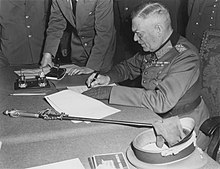
Keitel signs the surrender document in Berlin-Karlshorst, 8/9 May 1945.
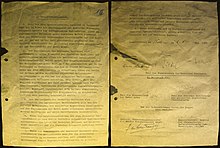
German Armed Forces surrender declaration, 8 May 1945 Berlin-Karlshorst
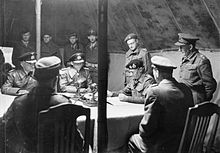
Signing of the partial surrender of the Wehrmacht for north-west Germany, Denmark and the Netherlands on 4 May 1945 in a tent on the Timeloberg near Lüneburg
.jpg)
Proclamation No. 1 from General Eisenhower to the German People, March 1945
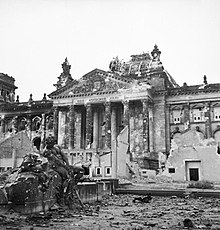
The Reichstag building in Berlin four weeks after the end of the war
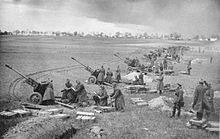
Soviet artillery (SiS-3), 60 km east of Berlin, April 1945
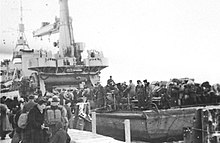
Unternehmen Hannibal, January 1945: Refugees from Königsberg on the air traffic control ship Hans Albrecht Wedel
![Hungarian soldiers with PAK fighting in a Budapest suburb. The war correspondent of the SS propaganda company commented in Nazi jargon: "November 1944, battle area Hungary. Only yesterday the enemy broke through here, but was immediately repulsed in the counterattack. [...] Hungarian Pak secures the sally-roads against renewed Bolshevik raids."](https://alegsaonline.com/image/220px-Bundesarchiv_Bild_146-1986-064-15,_Ungarn,_Straßenkämpfe,_ungarische_Pak.jpg)
Hungarian soldiers with PAK fighting in a Budapest suburb. The war correspondent of the SS propaganda company commented in Nazi jargon: "November 1944, battle area Hungary. Only yesterday the enemy broke through here, but was immediately repulsed in the counterattack. [...] Hungarian Pak secures the sally-roads against renewed Bolshevik raids."
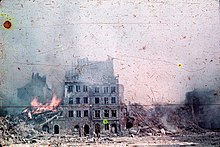
Warsaw Uprising, August - October 1944: burning house in the Old Town (Agfacolor photo). Photographer: Ewa Faryaszewska (1920-1944)
.jpg)
Abandoned war material of the German 9th Army near Babruysk (Belarus), end of June 1944.
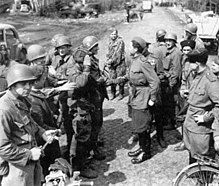
Elbe Day, US and Soviet troops near Torgau on the Elbe, 25 April 1945
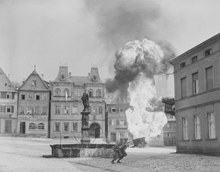
Two US soldiers flee when a petrol tank trailer explodes, Kronach (Upper Franconia), 14 April 1945.
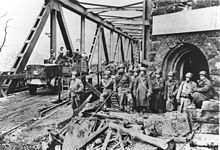
US soldiers at the Ludendorff Bridge near Remagen, 8/10 March 1945

Operation Market Garden: Paratroopers land near Arnhem, September 1944
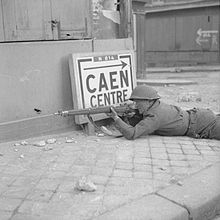
A British soldier keeps a lookout for German snipers in fiercely contested Caen, 9 July 1944.
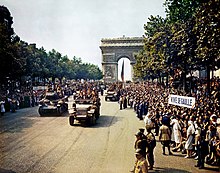
French patriots line the Champs-Élysées on 26 August 1944, the day after the liberation of Paris, as Free French troops from General Leclerc's 2nd Armoured Division pass the Arc du Triomphe

Landing in Normandy, situation until 30 June 1944
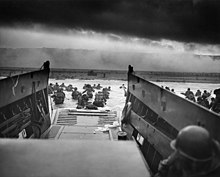
Into the Jaws of Death: US soldiers land on Omaha Beach, 6 June 1944.
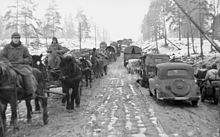
Retreat of German troops at Lake Ilmen, approx. 200 km south of Leningrad, February 1944
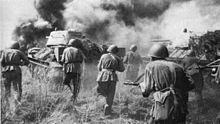
Red Army soldiers during a counter-offensive in the Battle of Kursk, July 1943.
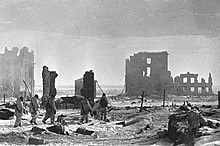
City centre after the end of the Battle of Stalingrad, 2 February 1943
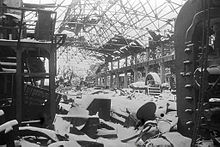
Stalingrad: Ruin of a factory hall of the "Red October" steelworks, 21 January 1943

German air raid on Stalingrad, 2 October 1942
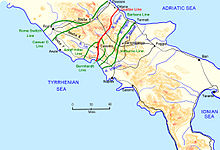
German Defence Lines in Lower Italy, Sept. 1943 - March 1944
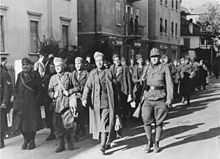
Italian soldiers guarded and disarmed by German soldiers in Bolzano, September 1943

Mussolini leaving the Campo Imperatore Hotel, 12 September 1943

Italian soldiers north of the Mareth Line on the march to captivity, March 1943

Erwin Rommel approx. 100 km west of the border with Egypt, 16 June 1942
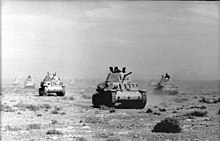
Italian M13/40 tanks in North Africa, approx. 70 km south of Tobruk, May 1941.

Destroyed aircraft after the attack on Pearl Harbor, 7 December 1941

Executed partisans in the Soviet Union, January 1943
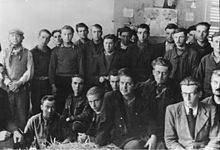
Arrested members of the Résistance in France
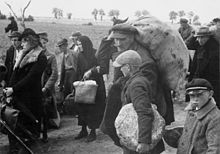
Expulsion of Polish population from German-occupied Wartheland, autumn 1939
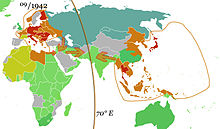
Sphere of influence and domination of the Axis powers in September 1942
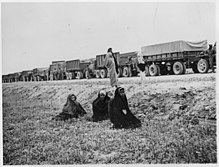
Women looking at an Allied supply convoy for the USSR on the "Persian Corridor", somewhere between Tehran and Bandar Pahlawi, June 1943 (today's name: Bandar Anzali).
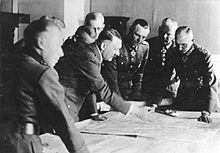
Briefing at the Headquarters of Army Group South in Poltava, 1 June 1942
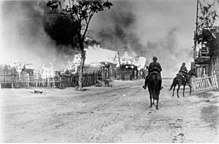
Two mounted German soldiers in a burning village near Mahiljou (Belarus), 16 July 1941
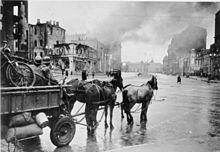
German "invasion" of Kharkov on 1 November 1941, photograph of a propaganda company.
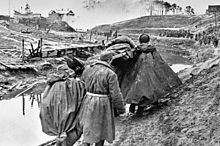
Soviet soldiers recovering a wounded man near Leningrad, October 1941

Russian campaign, 1941-1942
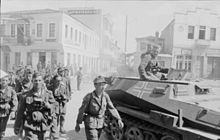
Invasion of German troops in Athens, May 1941
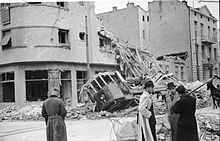
Destruction in Belgrade after air raid, April 1941
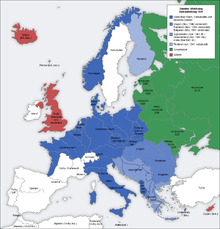
Balkan campaign, April - May 1941
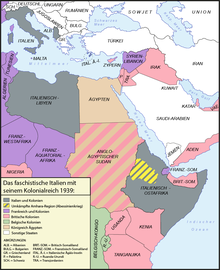
Fascist Italy with its Colonies in Europe and Africa (1939)
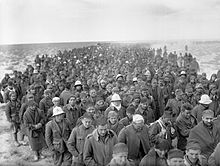
Italian prisoners of war during Operation Compass, after the battle of Bardia on the Libyan-Egyptian border, 6 January 1941.

Philippe Pétain and Adolf Hitler on 24 October 1940 in Montoire-sur-le-Loir (→ Le Loir is a left tributary of the Loire)

London after the Blitz, 28 December 1940
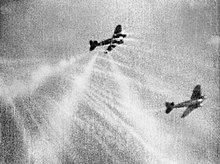
On-board camera of a Spitfire shows tracer ammunition hitting a He 111, over England on 25 September 1940.
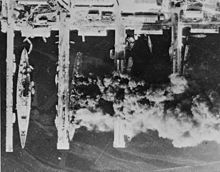
Burning French warships "Strasbourg", "Colbert", "Algérie" and "Marseillaise" in the port of Toulon, 23 November 1942

Hitler and entourage in front of the Eiffel Tower, 23 June 1940
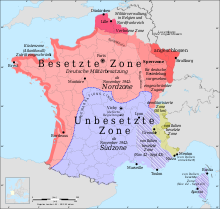
Occupied and unoccupied zone in France until November 1942

von Ribbentrop, Hitler, Göring, Raeder (behind Göring), von Brauchitsch and Heß in front of the Compiègne car, 21 June 1940

British soldiers in lifeboats on the beach near Dunkirk, 1940 (Film scene from Divide and Conquer (1943) by Frank Capra.)

The so-called "sickle cut" (May 1940) from Luxembourg to Boulogne and Calais on the Channel coast. The British and French troops operating there were thus cut off from their rear connections to northern France.
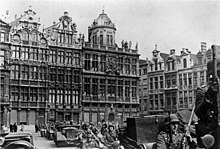
Combatless arrival of motorised German troops in the centre of Brussels, 17 May 1940

Rotterdam after bombing in May 1940 and subsequent demolition (1942)
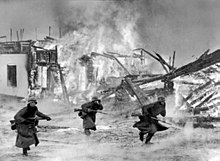
German soldiers fighting around a burning village in Norway, 40 km west of Lillehammer, April 1940.
.jpg)
Wehrmacht armoured reconnaissance vehicle in Viborg (Denmark), April 1940
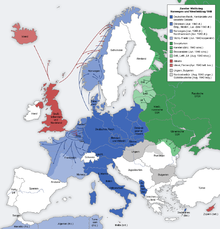
Norway and the Western Campaign 1940

Finnish territorial losses in the Peace of Moscow (1940) and the Peace of Paris (1947)
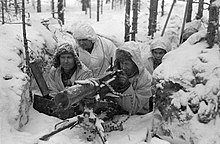
Finnish machine-gun position near Pitkjaranta (today's Russian name) on the north-eastern shore of Lake Ladoga, about 100 m from the Soviet front, 21 Feb. 1940.
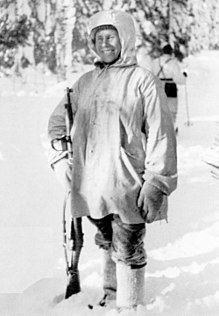
Simo Häyhä, used as a sniper during the Winter War (Dec. 1939 - March 1940) and dubbed "White Death" by Red Army soldiers, killed more than 500 Soviet soldiers during the Battle of Kollaa
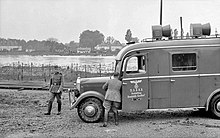
NSDAP loudspeaker van at the front on the Upper Rhine, 1939

On the left, Panzer-Kampfwagen I and II advancing near Bromberg in the Polish Corridor, September 1939. On the right, in Sd.-Kfz 251 with device for a sunshade, General Heinz Guderian.
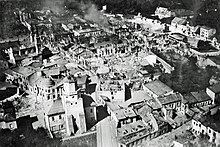
Wieluń after the air raid, 1 September 1939
.jpg)
German soldiers and Danzig provincial police reenact the destruction of a Polish turnpike on the border to the Free City of Danzig, 1 September 1939.
War in Asia and the Pacific
→ Main article: Pacific War
Japan's Reordering of East Asia
→ Main article: Prehistory of the Second World War in the Pacific Region
Japan had been involved in several wars before the Second World War. Under Tennō Yoshihito, Japan fought alongside the Allies in the First World War, in which Japan was able to take over colonies from the German Empire, including part of German New Guinea (Japanese South Sea mandate). About ten years earlier, the Russo-Japanese War (1904-1905) had occurred over the dispute for supremacy in Manchuria and Korea.
To overcome the economic crisis from 1929, influential politicians and military leaders proposed a territorial expansion of Japan. From the 1930s, they gained increased control of the government, including the office of prime minister; political opponents were persecuted and the media censored. The aggressive campaign for a reorganisation of the Pacific region was ostensibly aimed at ending the hegemony over the Asian countries and their colonies by Western, European states (Pan-Asian movement). In fact, it was the will to end Japan's economic difficulties by forcibly securing raw material and sales areas as well as settlement land for emigrants.
Japanese expansion was initially directed against the Republic of China. After the Mukden Incident on 15 September 1931, presumably orchestrated by the Japanese themselves, the Manchurian Crisis occurred three days later and a Japanese vassal state of Manchukuo was established in February 1932. After international protests over its actions in China, Japan withdrew from the League of Nations in 1933; in 1936 it joined the Anti-Comintern Pact.
On 7 July 1937, there was the Marco Polo Bridge incident in Beijing, which the Japanese army used as an opportunity to invade northern China without declaring war and to occupy the main ports along the entire Chinese coast. As it occupied the hinterland of Hong Kong and Macau, it blockaded almost the entire Chinese coast to cut off China's economic links overseas. These events are considered by some historians to be the real beginning of the Second World War. Nevertheless, the war in China was very different from the war in Europe, which began on 1 September 1939. In the spring and summer of 1940, when the German Wehrmacht overran the Netherlands, Belgium and France and "almost brought Britain to its knees", there was no end in sight to the Asian war.
China was at a crossroads at the time, as the communists under Mao Zedong and the Kuomintang nationalists under Chiang Kai-shek fought for supremacy in the country. The communists had retreated inland to Yan'an after the Long March and only intervened sporadically in the fight against the Japanese.
Around 8 December 1937, Japanese troops reached Nanjing, the capital of the Kuomintang, and encircled it. Chiang Kai-shek had the capital moved to distant Chongqing. The occupation of the city saw the Nanking Massacre over the next six weeks, in which at least 200,000 Chinese civilians and prisoners of war were murdered and some 42,000 women and girls of all ages raped. "Reports of the orgy of murder and rape shocked the world." Public opinion in the West, especially in the US, turned sharply against Japan. In July 1939, the US government terminated a major trade treaty that had been in place since 1911 and affected nearly a third of all Japanese imports. A way out of the increasing isolation seemed to be an alliance with Germany, which was advocated by the German Foreign Minister Ribbentrop.
The road to Pearl Harbor was not a one-way street, but in the summer of 1940 the Japanese leadership took decisive steps so that the two wars in Europe and Asia merged into a single global conflagration. Japan took advantage of the defeat of the Western powers and in June 1940 blackmailed Britain and France into stopping vital aid deliveries to the Chinese Nationalists via Burma and Indochina. The Dutch government-in-exile in London was pressured to export oil from the Dutch Indies to Japan. It also installed Wang Jingwei as head of a puppet government in Nanking.
Prince Konoe Fumimaro, who had become prime minister for the second time in July 1940, after the dramatic events in Europe, had argued in a memorandum in the same year that the war in China would ultimately lead to a "Greater East Asian Sphere of Prosperity", formed by Japan, Manchukuo and China as well as former colonies of Great Britain, the Netherlands and France. The term was coined by Matsuoka Yōsuke, foreign minister in the second Konoe cabinet. The Three-Power Pact with Germany and Italy of 27 September 1940 expanded the existing Anti-Comintern Pact to include mutual military support. With this, Japan discarded the neutrality it had proclaimed in September 1939 and underlined its aggressive foreign policy, especially towards China. The pact was not directed against the Soviet Union, but was primarily intended to keep the USA out of the war. The US reaction quickly showed how groundless Matsuoka's and Ribbentrop's claims that the Three-Power Pact would act as a deterrent had been. There was a growing view in the White House that Japan was an aggressive, bellicose power, an Asian counterpart to Nazi Germany that had to be stopped. This view was confirmed when, in September 1940, while negotiations with the French were still underway, Japan violently occupied the northern part of French Indochina in two days of fighting. The very next month, the USA imposed a total ban on exports of iron and steel scrap to Japan, and Britain reopened the Burma Strait for supplies to China.
The Japanese leadership wanted to take advantage of the defeats of France and the Netherlands and the expected defeat of Great Britain in the war against Germany to expand southwards (Indochina, the Dutch Indies, Hong Kong, Malaya and Singapore). On 25 June 1940, Army Minister Shunroku Hata told his staff, "Let us seize the golden opportunity! Nothing shall stop us!" With a Japanese seizure of the British, French and Dutch colonies in Southeast Asia, the possibility of a collapse of China would have been within reach. Moreover, the establishment of a Japanese hegemonic power in East Asia and the hegemony of a Nazi Germany in Europe would have meant that America would have faced an Old World jointly dominated by totalitarian powers, for the Soviet Union at that time seemed to be peacefully demarcating its sphere of influence with the Axis powers and Japan.
The year 1941 began with intensified efforts by the USA and Japan to avoid an impending war. At the same time, the Japanese war and conquest plans for Southeast Asia took concrete shape. In negotiations between US Secretary of State Cordell Hull and the newly appointed Japanese Ambassador Kichisaburō Nomura, the Japanese were willing to forego further southward action if the Americans allowed them to subjugate China. But the refusal to give Japan a free hand in China would ultimately trigger the Japanese attack on Pearl Harbor in December 1941. On 2 July, Japan decided to extend its territorial claim to Southeast Asia, where the rich mineral resources of the Dutch and British colonies were a worthwhile target. Two days after the occupation of the southern part of Indochina, which was needed as a springboard for this southern expansion, the USA, Great Britain and its dominions as well as the Netherlands Indies froze the Japanese foreign assets in their countries on 26 July 1941, which practically amounted to a complete export embargo - including of oil. Because of this embargo, war remained the supposedly only alternative for Japan because its oil reserves would be exhausted in two years at the latest. On 5 November 1941, the decision was made in Tokyo to launch the war the following month with attacks on Pearl Harbor, Malaya and the Philippines. The strategic goal was to gain dominance over Southeast Asia and the Western Pacific within eight months in order to be able to fight the United States from this power base for a longer period of time or to be able to force it into a negotiated peace to Japan's advantage. At the same time, the conferees reckoned that in the course of expansion, aid deliveries to China could be interrupted. Final negotiations in Washington between Nomura, the special envoy Saburō Kurusu and Hull to avoid war failed because of Hull's uncompromising demand for the withdrawal of all Japanese troops from China and Indochina. In return, the US wanted to release the Japanese assets. As was to be expected, when Hull's ten-point programme arrived in Tokyo on 27 November, it was taken as an ultimatum - practically an insult. The Imperial Conference of 1 December 1941 stated that Japan could not tolerate the "extremely haughty, obstinate and disrespectful" attitude of the United States.
In the attack on Pearl Harbor on 7 December 1941, Japanese aircraft launched from six aircraft carriers sank five battleships in two waves, three of which were later refloated, and 14 other major US warships. Vice Admiral Nagumo, the commander of the Kidō Butai aircraft carrier group, did not launch a third wave of attacks because he was concerned about the location of the absent three US carriers that could launch a heavy counterattack. This decision left docks and shipyard facilities intact, as well as replenishment depots and fuel storage, allowing the US to rapidly rebuild its Pacific fleet over the next six months. The next day, the United States Congress declared war on Japan, followed on the same day by those of Britain, its Dominions and the Netherlands. On 10 December, off the east coast of the Malay Peninsula, the British battle cruiser Repulse and the modern battleship Prince of Wales, which had been commissioned only a few months earlier, were sunk by Japanese torpedo planes. The sinking of the two capital ships was a clear sign of the emerging loss of importance of such large warships compared to land- and sea-based air forces.
Over the next few months, the Japanese pushed further south and, ideologically prepared by the battle cry "Asia for the Asians", occupied European colonies such as Hong Kong, parts of Burma and India, British Malaya, Singapore and the Dutch Indies. In the Philippines, occupied by Japan from 1942 to 1945, "1 million Filipinos [.] were massacred by Japanese soldiers."
From Pearl Harbor to the Japanese Surrender
Within four months (December-March), Japanese troops had taken control of large parts of Southeast Asia and a large part of the Pacific islands with about 450 million people. This was the greatest expansion of Japanese power in the history of the empire. The conquests of Malaya and the Dutch Indies were particularly important for Japan because of their rich ore deposits, extensive rubber production and large oil fields. 139,000 British, Australians and Indians were forced to surrender on 15 February 1942 in Singapore, the "Gibraltar of the East" and Britain's largest military base in Southeast Asia. The Battle of Singapore is seen as emblematic of the Japanese Blitzkrieg, and later of the brutality of Japanese soldiers, as more than 11,000 of the Allied prisoners died of starvation and exhaustion while building the Thailand-Burma railway. The invasion of Burma began on 15 February 1942, and Dutch India was conquered in mid-March 1942. In the Philippines, General Douglas MacArthur soon had to evacuate Manila and retreat to Corregidor Island, where the last US troops surrendered on 5 May 1942. Nothing seemed to be able to stop the Japanese.
After the capture of Rabaul on the north-eastern tip of the island of New Britain (January 1942), the Japanese had gained an excellent starting point for a further advance towards the Eastern Pacific and South Seas.
The Battle of the Coral Sea (early May 1942) ended in a draw (one sunk and one badly damaged aircraft carrier on each side), and the Japanese abandoned their intention to land at Port Moresby in southern New Guinea, allowing the Allies to hold an apron north of Australia. It was the first combined sea-air battle in naval warfare history. Despite the setback in the Coral Sea, the Japanese forces could be satisfied so far: 340,000 Allied soldiers had been taken prisoner and the Allied fleets had lost eight battleships, two aircraft carriers, seven cruisers and numerous smaller warships. In the Battle of Midway, where Yamamoto assumed the US Navy had only two carriers left - which he also thought were in the South Pacific - he believed he could challenge the remaining US Pacific Fleet to a decisive battle. But the US fleet was informed in detail about the enemy's plans thanks to its radio reconnaissance. In air attacks by aircraft from three US carriers, the Japanese navy lost four aircraft carriers and 200 aircraft with particularly experienced pilots and pilot trainers. Their fleet had been so severely weakened that Japanese superiority in sea-air warfare was lost. The battle "is rightly regarded as the turning point of the war in the Pacific.
After building an airfield on Guadalcanal, Japan could have threatened Allied shipping between the US and Australia. The US Navy deployed its only remaining intact Marine Infantry Division (USMC) in August 1942 to capture the airfield, which was quickly accomplished. Stubbornly, the Japanese tried to retake the island. Only after months of fighting did the Allies finally succeed in holding their ground on the island (→ Battle of Guadalcanal). This success marked another turning point in favour of the USA, which now not only possessed more warships and aircraft, but was also tactically superior.
Very hard fighting took place from the end of 1942 to mid-1944 on New Guinea, the Solomon Islands, the Gilbert Islands, the Marshall Islands and the Marianas. One successful tactical tool was "island hopping", in which the Americans bypassed the strong Japanese bases, for example the important Rabaul with its harbour and airfields, and fought their way closer to the main Japanese island of Honshū island by island.
At the beginning of 1943, the Americans succeeded in deciphering Japanese radio codes. This also increased the successes of the US submarines, whose steadily increasing successes played a significant part in the victory over Japan. They torpedoed about one third of 686 Japanese warships. Throughout the war, the Japanese navy failed to develop an effective protection system for its transport shipping. This was due both to the underestimation of the submarine danger in Japanese military doctrine and to Japan's great technological inferiority in the field of radar and underwater sound detection. Above all, the subsequent shortage of fuel made it necessary to station fleet units far outside the main combat areas, close to fuel sources, which severely limited the tactical and strategic options of the Japanese fleet.
In April 1943, the Americans managed to shoot down five escort planes from Guadalcanal of Yamamoto's plane, which was on an inspection flight. Admiral Yamamoto, Commander-in-Chief of the Japanese Navy, was killed when his plane crashed into the jungle. The loss of this leadership and identification figure was a heavy blow to the Japanese public (→ Operation Vengeance).
In November 1943, shortly before the meeting with Stalin in Tehran, Roosevelt and Churchill agreed with Chiang Kai-shek in Cairo that the war against Japan, like that against Germany, should end with unconditional surrender. Chiang Kai-shek was thus recognised not only as the representative of China, but also as the head of state of a great power.
From 1944 onwards, the period of success of the US task forces began, which appeared surprisingly off the coast of Japan with fast carrier raids and attacked targets of all kinds almost at will. The Japanese responded by using kamikaze planes and manned Kaiten torpedoes. The high losses of US warships expected by the Japanese failed to materialise.
In the Battle of Saipan, which began in mid-June 1944 and was linked to the Battle of the Philippine Sea, the Japanese lost almost all of their aircraft and crews and three aircraft carriers through submarines. The loss of Saipan triggered a political earthquake in Japan: General Tojo's government was forced to resign and was replaced by a cabinet under General Koiso Kuniaki, who immediately lowered the compulsory military age to 17. At the end of October to the beginning of November 1944, during the landings on Leyte (Philippines), there was a naval and air battle in Leyte Gulf. Japan deployed most of its fleet, making the fighting for Leyte the largest naval battle of World War II. With four aircraft carriers, three battleships, ten cruisers and nine destroyers, the Japanese lost almost their entire remaining naval force.
It was only after the conquest of the Mariana Islands in the summer of 1944 that Japan was within the radius of action of the USAAF's new Boeing B-29s. The US Air Force went on nightly area bombing raids from relatively low altitudes on the predominantly wooden Japanese cities, killing hundreds of thousands of people. In the largest attack of this kind, some 85,000 people died in Tokyo on the night of 9 March 1945, more than in any other air raid in the Second World War and almost as many as from the atomic bombing of Hiroshima. Further air raids destroyed numerous major Japanese cities until the end of the war.
In Operation Hailstone, the important Japanese naval base Truk in the Caroline Islands was attacked on 17 February 1944. Twelve torpedo bombers of the US carrier Enterprise were able to attack the Japanese ships lying in the lagoon during the first radar-based night attack. Despite heavy defensive fire, they were only able to shoot down one US aircraft. With losses of over 200,000 GRT and heavy damage to installations, this attack is also known as the Japanese Pearl Harbor.
The reconquest of the Philippines proved to be a long and costly campaign lasting six months (October 1944-March 1945). The US losses, 8,000 men, were offset by disproportionately higher Japanese losses, as was usually the case in the Pacific War: 190,000 Japanese fell on the island of Luzon alone.
During the fighting on the Japanese islands of Iwojima and Okinawa, US ships were attacked by large numbers of kamikaze planes. US forces lost nearly 7,300 marines and about 5,000 sailors and pilots. 36 US Navy ships sank and nearly 400 aircraft were destroyed. The Japanese lost 113,000 soldiers and, with the kamikaze planes, about 7,800 aircraft.
After the fighting on Iwojima and Okinawa, the first atomic bomb was dropped on Hiroshima on 6 August 1945 by a B-29 bomber launched from Tinian. Shortly afterwards, on 9 August, the second was detonated over Nagasaki. In Hiroshima 70,000-80,000 people were killed instantly, in Nagasaki about 20,000.
The Soviet Union stood by its commitment made at the Yalta Conference to start the war in the Far East 90 days after the end of the war in Europe and to attack Japan and its allies. The Red Army fulfilled this commitment to the day (8 August), after the neutrality pact with Japan had already been terminated in April 1945. With Operation August Storm, Manchuria was occupied. The conquered territory was returned to the Republic of China by the Soviet Union in 1946 in accordance with the Allied war aims (Cairo Declaration).
A few days later, on 15 August 1945, the Japanese Tennō announced Japan's surrender in a radio address (Gyokuon-hōsō), which was signed on the USS Missouri in Tokyo Bay on 2 September.
The occupation of the main Japanese islands was carried out by US troops alone, while the other powers involved (Great Britain, the Soviet Union and China) took part in the occupation of the formerly Japanese outer territories.
The state of war between Japan and the Allies formally ended on 28 April 1952 with the signing of the San Francisco Peace Treaty, but without the PRC, the Soviet Union and India.

"Little Boy" at the US base Tinian before loading into the B-29 bomber Enola Gay. Length: 3.2 m, diameter: 0.71 m, uranium mass: 38.4 kg

Hiroshima, after the dropping of the atomic bomb, 6 August 1945

Allied counter-offensive 1943-1945 in East Asia
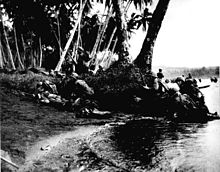
US landing on Rendova (Solomon Islands) on 30 June 1943
.svg.png)
Japanese sphere of power in March 1942
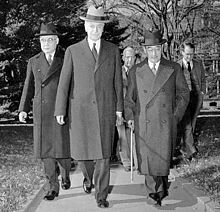
Secretary of State Hull (centre) with Japanese Ambassador Kichisaburō Nomura (left) and Special Envoy Saburō Kurusu (right) on their way to the White House, 20 November 1941.
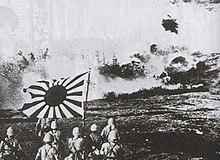
Japanese fighting near Canton, October 1938
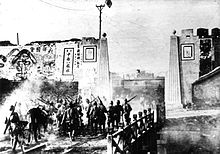
Japanese troops during the capture of Tanyang, December 1937

Pacific War 1937-1942
Strategic aspects
Strategy historian Colin Gray interprets the Second World War, with its operations on three continents on land, at sea and in the air, as a complex event that was permeated by an "elegant simplicity in its course and structure". According to Gray, the two main theatres of war, the Eastern Front and the Pacific, were fundamentally independent of each other. However, important events such as the German declaration of war on the United States after the Japanese attack on Pearl Harbor often established war-related connections. What they had in common was that both campaigns were "huge siege operations". Moreover, Gray classifies the Second World War as a war of attrition, despite an increase in linked combat compared to the First World War, such as the Blitzkrieg.
Air war
→ Main article: Air warfare in the Second World War
In the invasion of Poland, the Luftwaffe had air supremacy, as the Polish air forces with their largely obsolete aircraft could offer little resistance. The air raids on Warsaw in September 1939 were mainly on civilian targets. After the invasion of the Netherlands, Belgium and Luxembourg, the Luftwaffe completely destroyed the old city during the bombing of Rotterdam on 14 May 1940.
In the first months of the Battle of Britain, German attacks were still directed exclusively against military targets such as air bases, naval bases and the facilities of the chain home radar chain. However, the units of the British Fighter Command were able to maintain air superiority over the attackers. The air battle became more radical when the Luftwaffe flew a first strike on London on 24 August 1940 and Churchill ordered the bombing of Berlin in retaliation. By the end of the year, some 14,000 people had died in London.
On 14 November 1940, the Luftwaffe flew a heavy air raid on Coventry. At least 568 people were killed. In addition to vehicle and engine factories, thousands of residential buildings were hit and the medieval St. Michael's Cathedral was destroyed. Nazi propaganda invented the term "coventriering" for the area bombing. From May 1940 onwards, the Royal Air Force attacked German cities (e.g. Munich Gladbach) and industrial plants such as the Deurag-Nerag refinery (→ air raids on Hanover) in needle-like fashion. After the Luftwaffe broke off the Battle of Britain in early 1941 and moved most of its bombers and fighters to the east because of the planned attack on the Soviet Union, the RAF flew more night raids on major German cities.
During the air raid on Belgrade on 6 April 1941, the Luftwaffe destroyed large parts of the city, which could only be weakly defended. The Luftwaffe played a significant role in the German offensiveagainst the Soviet Union, but could not decide either the battle for Moscow or the battle for Stalingrad for the German side. German bombers and fighters were mostly used only for close air support of the army troops. The United States Army Air Forces (USAAF) flew the first bombing raid on Tokyo in April 1942; from August 1942, the 8th Air Fleet of the USAAF began its own air raids in Europe.
Since the bombing raids with a few aircraft had high loss rates and mostly missed their target, the RAF switched to sending large bomber squadrons to Germany from spring 1942 onwards to destroy cities over large areas. On 14 February 1942, the British Air Ministry issued the Area Bombing Directive, which called for area bombing of civilian targets (city centres, residential areas and others). The new commander-in-chief of RAF Bomber Command, Arthur Harris, was told that he could use his forces without restriction: "You are accordingly authorised to use your forces without restriction [...]". In addition, Harris was informed that operations were to be focused on the morale of the enemy civilian population - in particular the industrial workers: "It has been decided that the primary objective of your operations should be focused on the morale of the enemy civil population and in particular the industrial workers". The aim of the morale bombing was not only to destroy industrial plants, but above all to weaken the population's will to resist. In addition, the Dehousing Paper, written six weeks later, defined the strategic goals of the British air war against Germany.
The implementation of these goals began in 1942 with the air raids on Lübeck at the end of March and Rostock at the end of April. The first "thousand bomber raid" was directed against Cologne at the end of May (Operation Millennium), followed by numerous attacks on cities in the Ruhr area. In January 1943, Bomber Command flew the first major raid on Berlin. Here, for the first time, Pathfinder aircraft dropped target bombs. At the end of the same month, the USAAF also attacked submarine yards in Wilhelmshaven for the first time. In March 1943, the German armament centre of Essen was attacked by the RAF and the Krupp cast steel factory was badly hit, delaying the production of the Tiger and Panther tanks, which led to the postponement of the Citadel enterprise at Kursk. Göring withdrew more and more fighter squadrons from the Eastern Front for the protection of German cities. The negative impact on the course of the war in the east was probably much greater than the kills the fighters were able to inflict on the Allied bombers. In this spring of 1943, the losses of the Allied bomber fleets became worrying. Not even a fifth of the RAF's crews survived a cycle of 30 sorties. The US 8th Air Fleet lost so many aircraft to shoot-downs that it was no longer able to establish the air superiority necessary for the success of an invasion of Western Europe that year. In August 1943, Hamburg was destroyed in Operation Gomorrah, in which an estimated 34,000 people lost their lives in the firestorm. The USAAF concentrated its daytime raids mainly on industrial targets, while RAF bombers bombed the cities at night. The US bomber units initially suffered considerable losses, for example in the attacks against Schweinfurt and Essen. From spring 1944 onwards, when more long-range fighters (P-38s, P-47s and P-51s) accompanied the USAAF bombers, the casualty figures dropped significantly. With the massive air raids, the Allies also hoped to provoke increased resistance against the Nazi regime and thus shorten the war.
In the course of 1944, Allied air superiority increased to such an extent that bombers flew into Reich territory almost daily. During the Big Week in February 1944, selected targets of the German armaments industry were attacked with 6,000 bombers from the RAF and USAAF. When refineries and hydrogenation plants important to the war effort, including the Leunawerke, were increasingly bombed from May 1944 onwards, the fuel supply of the Army and especially the Luftwaffe was severely affected. With the subsequent loss of 90% of German petrol production, the war was also "lost in terms of production" for the German Reich, according to Armaments Minister Albert Speer. The air raid on Ploiești on 19 August 1944 destroyed another important source of fuel.
The heavy air raids on Dresden from 13 to 15 February 1945 killed between 22,700 and 25,000 people. To this day, they are the subject of controversial considerations between military necessity or breach of the international law of war at the time. At the same time, smaller cities such as Pforzheim, Swinemünde, Würzburg, Hanau, Hildesheim, Wesel and Paderborn were also destroyed on a large scale by the end of March 1945. Around 600,000 Germans and 60,595 British died in the bombing campaign. Of the 125,000 volunteers of RAF Bomber Command, more than 55,000 airmen lost their lives, more than in any other British branch of the armed forces.
With the two new developments of the V1 cruise missile and the V2 ballistic missile, the National Socialist leadership hoped for a "miracle weapon". Since both had only low hit accuracy, they were unsuitable for the targeted destruction of military targets. Of the 7500 V1s launched against England from June 1944, more than half were shot down by British flak, which could use the radar proximity fuze newly developed in the USA, and by fighter planes. But among the German population, hopes of a turn towards the "final victory" could be rekindled or kept alive, for example in the whispering propaganda: "There's still something to come! That's not all yet!" Their function was primarily to terrorise the British civilian population. By March 1945, some 3200 A4 rockets had been fired, mainly at London and later the port of Antwerp.
In the Pacific War against Japan, the USAAF switched to area bombing of Japanese cities from relatively low altitudes after unsuccessful precision attacks from high altitudes. The US air raids on Tokyo in February and March 1945 almost completely destroyed the city, which consisted mainly of wooden houses, killing over 100,000 people. Hundreds of thousands of people were killed in the bombing of other major cities. The final point was the US atomic bombs dropped on Hiroshima and Nagasaki on 6 and 9 August 1945, which were intended on the one hand to force Japan to surrender militarily and on the other to send a political signal of military strength in the emerging bloc confrontation.
Atlantic and submarine warfare
→ Main article: Battle of the Atlantic and Unternehmen Rheinübung
The sinking of the British steamer Athenia on 3 September 1939 marked the beginning of the German U-boat war in the Atlantic. Planned as a propaganda strike by Rear Admiral Karl Dönitz, Captain Lieutenant Günther Prien succeeded in penetrating the Bay of Scapa Flow with U 47 on 14 October 1939 and sinking the battleship Royal Oak of the British Navy in the main base of the Home Fleet, killing over 800 men. Whereas until the middle of 1940 actions were mainly carried out by individual U-boats, after the conquest of France U-boats were able to reach the operational areas in the North Atlantic and off the English Channel much more quickly from five U-boat bases (initially provisional, later with massive bunkers) on the Atlantic coast. The Allied convoys were only weakly secured due to the lack of escorts. In addition, the U-boat commanders used the new tactic of a nighttime surface attack, which rendered the Allied ASDIC sonar devices, which could only locate underwater targets, ineffective.
The subsequent sinkings by German submarines were exploited by National Socialist propaganda; many commanders were stylised as heroes and decorated with medals. The Allies lost 4.4 million GRT of shipping space in 1940 and 1941 each, which were offset by only 1.2 and 2 million GRT of newbuildings.
In order to increase the pressure on the British supply transports and to support the submarine warfare, a squadron set sail from Gotenhafen in May 1941 for the Atlantic. It consisted of the battleship Bismarck, which had just entered service, the heavy cruiser Prinz Eugen, which had also only been in service for a few months, and several destroyers. The operation, code-named Unternehmen Rheinübung, led to the sinking of the British battle cruiser HMS Hood on 24 May 1941 and ended three days later with the sinking of the Bismarck.
After Germany's declaration of war on the United States on 11 December 1941, Vice Admiral Dönitz dispatched long-range submarines to the east coast of the USA (Unternehmen Paukenschlag), where they arrived in the first days of January 1942. The initially poorly organised US coastal defences were helpless in the face of the attacks on merchant shipping. As defences increased in the spring, submarine commanders diverted to the Caribbean and South Atlantic. After having six Brazilian merchant ships torpedoed there, killing nearly 1,000 sailors and passengers, Brazil became the only South American state to declare war on the German Reich on 22 August 1942 and sent an expeditionary force to Italy in 1944. Other German boats were operating in packs in the North Atlantic at the same time and were thus able to keep up the pressure on the convoys. Several major convoy battles occurred that year. In the autumn of the same year, the U-boats' successes increased even more, as many Allied convoy forces were deployed to secure transports to North Africa (material for Operation Torch). In 1942, 8.2 million GRT of Allied shipping were sunk; 7.2 million GRT were newly built (see below).
At the end of 1942, British cryptanalysts at Bletchley Park near London succeeded once again in breaking the German submarines' radio traffic, which had been encrypted with the help of ENIGMA. Decryption of German radio traffic, underwater sound detection from ships and radar detection from aircraft created a disastrous situation for the German submarines from 1943 onwards. In May 1943, the Allies were able to take full advantage of the improvement in the technical equipment of the escort ships through radar, ASDIC sonar equipment, automatic radio direction finders (Huff-Duff) and Hedgehog grenade launchers as well as their air superiority by means of escort aircraft carriers, so that 43 German U-boats were sunk in that month. Grand Admiral Dönitz then temporarily suspended submarine warfare on 20 May. "This also marked a decisive turning point in the naval war in favour of the Allies."
After the Allied landings in Normandy, in early June 1944, the German submarine bases on the French Atlantic coast were soon partially lost; some could be defended as cut-off fortresses until the end of the war (including Lorient, St. Nazaire and La Rochelle). The submarines were pushed back into the North Sea, the Baltic Sea and Norwegian coastal waters or operated more frequently off the British east coast. The most modern submarine of the time, the Type XXI, was not used again until the end of the war. When the imminent surrender of the Wehrmacht became known, Operation Rainbow was launched on 4 May 1945: although Dönitz's order that day was to surrender all ships, most of the U-boats were sunk by their crews themselves. After 8 May, the majority of the remaining boats called at British or US ports.
Ship space balance of the trade war:
| Year | Lossdt | Balance sheet of the Allies |
| 1939 | 9 | - 478,000 GRT |
| 1940 | 21 | - 3,188,000 BRT |
| 1941 | 34 | - 2,414,000 BRT |
| 1942 | 88 | - 1,063,000 BRT |
| 1943 | 225 | + 10,974,000 BRT |
| 1944 | 247 | + 11,927,000 BRT |
| 1945 | 132 | + 3,376,000 BRT |
| Total | 782 | + 19,134,000 BRT |
War material deliveries to the Soviet Union
War material deliveries by Great Britain and the USA to the Soviet Union (in tonnes) via:
| PersianGulf | Pacific | North Atlantic | Black Sea | SovietArctic | Total | |
| 1941 | 13.502 | 139.299 | 153.977 | - – | - – | 360.778 |
| 1942 | 705.259 | 734.02o | 949.711 | - – | 64.107 | 2.453.097 |
| 1943 | 1.606.979 | 2.388.577 | 681.043 | - – | 117.946 | 4.794.545 |
| 1944 | 1.788.864 | 2.848.181 | 1.452.775 | - – | 127.802 | 6.217.622 |
| 1945 | 44.513 | 2.079.320 | 726.725 | 680.723 | 142.538 | 3.673.819 |
| Total | 4.159.117 | 8.243.397 | 3.694.231 | 680.723 | 452.393 | 17.499.861 |
| Percent | 23,8 % | 47,1 % | 22,7 % | 3,9 % | 2,5 % | 100 % |
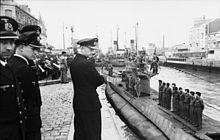
Karl Dönitz at the arrival of U 94 in the harbour of Saint-Nazaire, June 1941

21 June 1943: Launch of an A4 rocket (V2) from test stand VII of the Peenemünde Army Experimental Station on Usedom
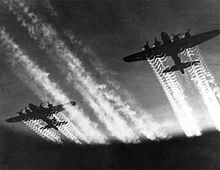
B-17 Flying Fortress in the night sky over Europe
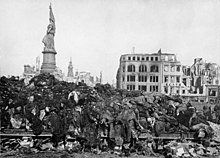
February 1945: Victims of the air raids on the Altmarkt in Dresden
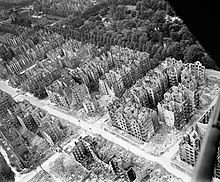
Rows of houses on Eilbeker Weg burnt out during the air raids on Hamburg in 1943/1945
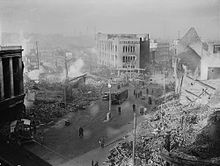
Coventry city centre after the German air raid of 14 November 1940
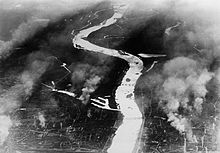
The Vistula bridges in Warsaw during German air raids, September 1939

Operation Rhine Exercise, 24 May 1941
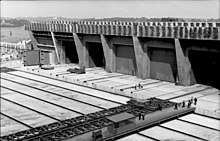
Construction of the submarine bunker in Lorient, April 1942

German submarines in the Brest bunker, 1942
Visualisation of the World War
Contemporary Colour Photographs
- Photos of the Imperial War Museum in London
Reports
- Global War - The Second World War
- Part 1: Fascism spreads, 2005.
- Part 2: Restoring the Powers, 2005.
- Part 3: The Liberation, 2005.
- Parts 1 - 3, 2008 (1 DVD).
- The Second World War - The DVD Encyclopaedia, 2003. ( → https://geizhals.de/der-zweite-weltkrieg-die-enzyklopaedie-a85808.html)
- Second World War (Stalingrad Box), 2003.
- The Second World War in Original Colour Photographs 1-3, 2002.
- That was the Second World War. Great Britain 2009. Shown in: ARD-alpha, 4 May 2018.
- The World at War, 26-part BBC documentary, 1973. Trailer: https://www.youtube.com/watch?v=p78JZgKtFRc
Feature films
- List of war films - World War II
- Why We Fight (1942-1945): Under the direction of Hollywood director Frank Capra, eight contemporary reportages were produced, each with a running time of 40 to 76 minutes.
- Prelude to War (1942) (Video - Internet Archive)
- The Nazis Strike (1943) (Video - Internet Archive)
- Divide and Conquer (1943) (Video - Internet Archive)
- The Battle of Britain (1943) (Video - Internet Archive)
- The Battle of Russia (1943) (Video - Internet Archive)
- War Comes to Europe (Video - Internet Archive)
- The Battle of China (1944) (Video - Internet Archive)
- War Comes to America (Video - Internet Archive)
Museums
- Museums about the Second World War
See also
![]()
Portal: Imperialism and world wars - Overview of Wikipedia content on the subject Imperialism and world wars
![]()
Portal: Pacific War - Overview of Wikipedia content related to the topic Pacific War
- Military operations in the Second World War
- The Third World in the Second World War
- Attacks on North America during the Second World War
- List of war gravesites
- Destroyed in the Second World War (category)
Questions and Answers
Q: What were the two military alliances during World War II?
A: The two military alliances during World War II were the Allies and the Axis Powers.
Q: How many people died in World War II?
A: Estimates suggest that between 50 to 85 million people died in World War II, most of whom were civilians.
Q: When did Japan invade China?
A: Japan invaded China on July 7, 1937.
Q: When did Germany invade Poland?
A: Germany invaded Poland on September 1, 1939.
Q: When was the Battle of Stalingrad fought?
A: The Battle of Stalingrad was fought in 1942.
Q: What event caused Japan to formally surrender?
A: Japan formally surrendered after two nuclear bombs were dropped on them in 1945.
Q: What happened after World War II ended?
A: After World War II ended, the United Nations was set up to develop support between countries and prevent future wars, decolonization of Asia and Africa occurred as Europe had been weakened by the war, economic recovery took place, and political integration (the process of uniting countries) began.
Search within the encyclopedia
